Every antique furniture enthusiast has heard of the name Gillows of Lancaster, due to the very high standard of craftsmanship and unique design of the pieces of furniture they constructed. Robert Gillow was the founder of Gillows and began cabinet making and finishing furniture from 1731 onwards after he had finished his apprenticeship as a joiner and cabinet maker. He actually became a Freeman of Lancaster in the year 1728 and went into business partnership with George Haresnape. He had two sons who joined him in his business, Richard and Robert. These two sons expanded the business to London to where many of the wealthiest buyers lived and this is where the firm quickly got recognized to be one the best cabinet makers of their time. In the 1740s, Gillows chartered ships, to import Mahogany from the west indies and Jamaica. This is why the timber used was of such good quality, as it was old slowly grown solid woods, woods you cannot see in today’s marketplace.
Gillows not only used timbers such as solid mahogany, but unusual veneers and painted designs such as Japanning. They often made upholstered chairs, so had their own upholsterers and cabinetmakers.
Amazingly not only did they produce there own fantastic designs, they also used other well known designers such as Chippendale, Sheraton and Hepplewhite. They also were creators of unique furniture like the trou-madame, a ladies version of a billiard table. It invented the extending telescopic dining table, the revolving top library table and secretaire drawers.
The Davenport desk was one of their most famous inventions, a small ladies desk first produced for captain Davenport. Gillows also made linen presses, chest of drawers, small occasional tables all the way to coffins. This lead to them becoming one of the richest families in England of the time.
The firm continued as Gillows until the early 1900s. They had overtime diversified to offer the complete interior design for your home from furniture, metalwork, stained glass, wallpaper, upholstery bespoke pieces including cabinet work for some larger homes, Libraries and offices.
Towards the late Victorian era, finances were becoming difficult with the new influx of mass produced furniture and so they joined together with Waring of Liverpool. In 1903 Waring took over Gillows, and the brand Waring & Gillow was borne. They diversifies again into not only quality furniture but also the luxury ships liner market. This went on for quite a few years but it didn’t last long enough as the market place changed again and unfortunately the company went bankrupt. It was then taken over by Maple & Co, to become Maple, Waring and Gillow, three major cabinet makers throughout history joined together from large greatness down to a small firm but it was not to last.
The sign of a genuine Gillows piece of furniture.
Unfortunately a very large portion of Gillows furniture was not stamped so you see many pieces associated to Gillows, due to the style, and design. The Gillows stamp can sometimes be seen under table tops, on the top edges of drawers, on the back legs of chairs or sometimes the signature would be written in pencil under drawer linings by the cabinet makers of the firm. You can look in the Gillows books to see the names of cabinet makers to reference with their signatures. The earliest marks were in the form of a printed label ‘Gillow and Taylor’ and this is very rare to find as they would rip or fall off over time. ‘Gillows Lancaster’ stamp was seen from the 1780s up to around the 1850s/60s, when it was changes to ‘Gillow’. In the 1860s, the mark consisted of a capital L, and a serial number with Gillows Lancaster could be seen. Late Victorian pieces produced the stamp ‘Gillow & Co’ and then Waring & Gillow along with a small brass plate. sometimes it can be seen on brass fittings such as locks.
Antiques World always has a fine selection for sale, so it is worth looking through our inventory. Previous examples include –
This Spectacular Quality Chippendale Period Gillows Antique Georgian Mahogany Linen Press

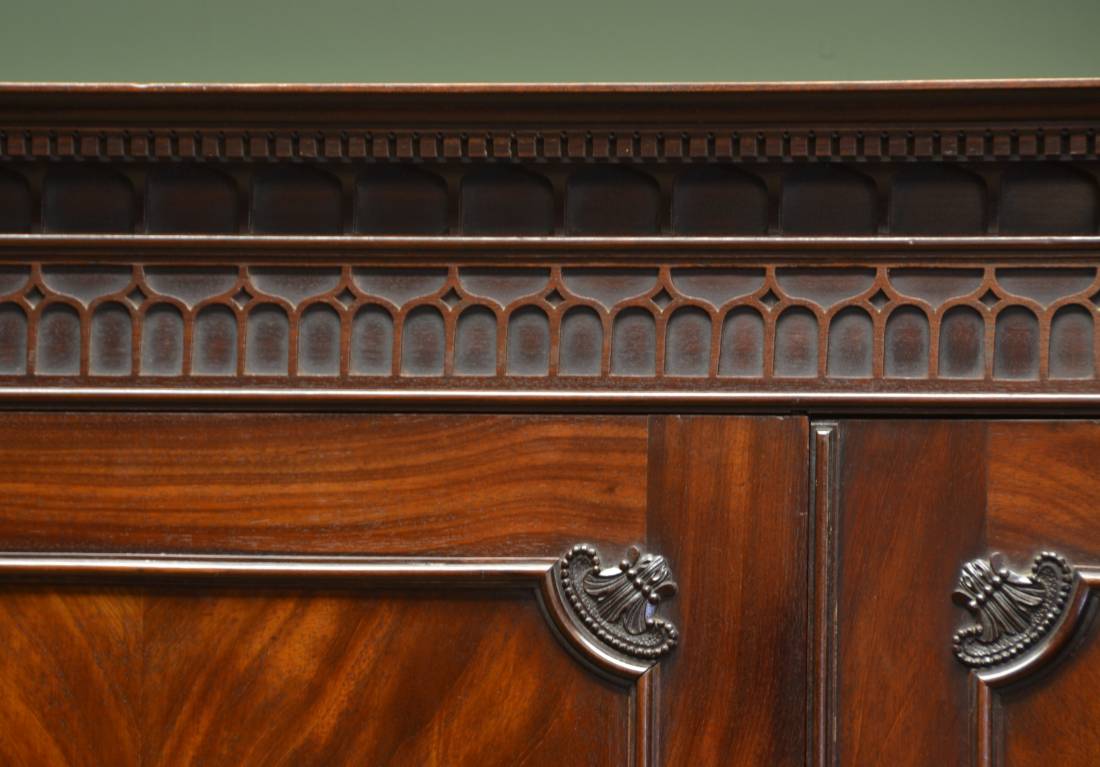
This Genuine Antique Mahogany Writing Table is Stamped with the Letter L 1126
This table is based on the design for a ‘Universal’ table published by Thomas Sheraton in his Cabinet-Maker and Upholsterer’s Drawing-Book, London, 3rd Edition, 1802, pl.25. Sheraton wrote that ‘The use of this piece is both to answer the purpose of a breakfast and dining-table. When both the leaves are slipped under the bed, it will then serve as a breakfast table; when one leaf is out, as in this view, it will accommodate five persons as a dining-table and if both are out, it will admit of eight, being near seven feet long, and three feet six inches in width’.
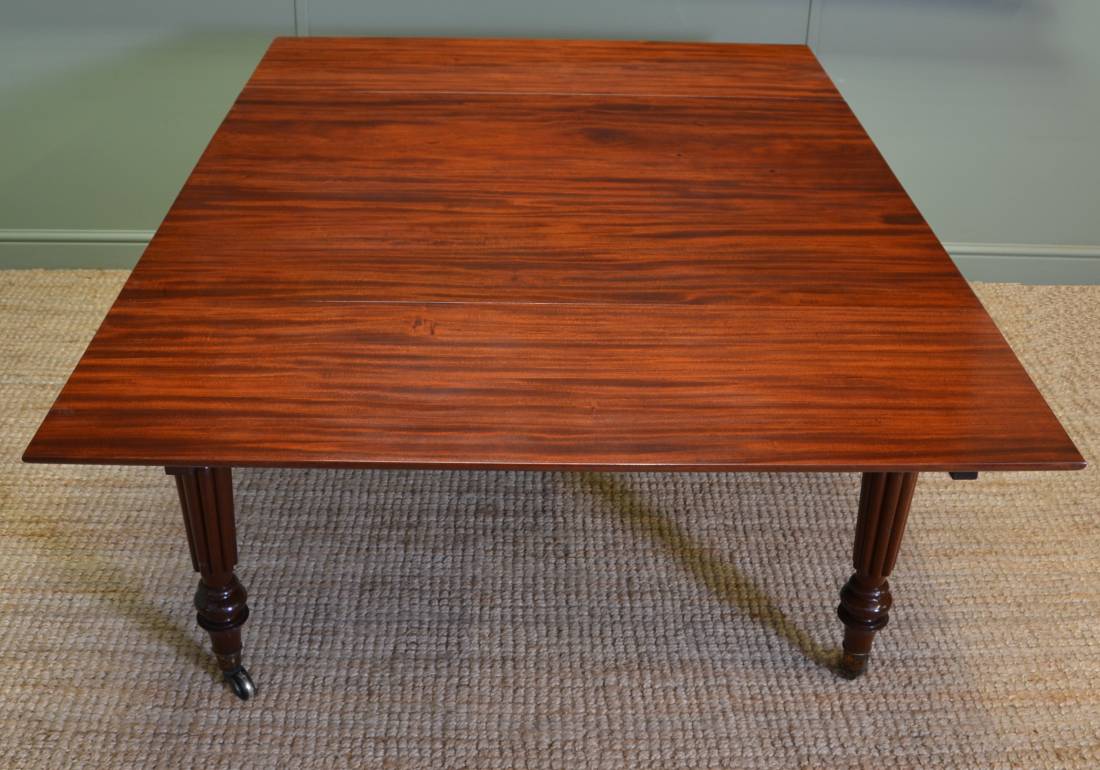
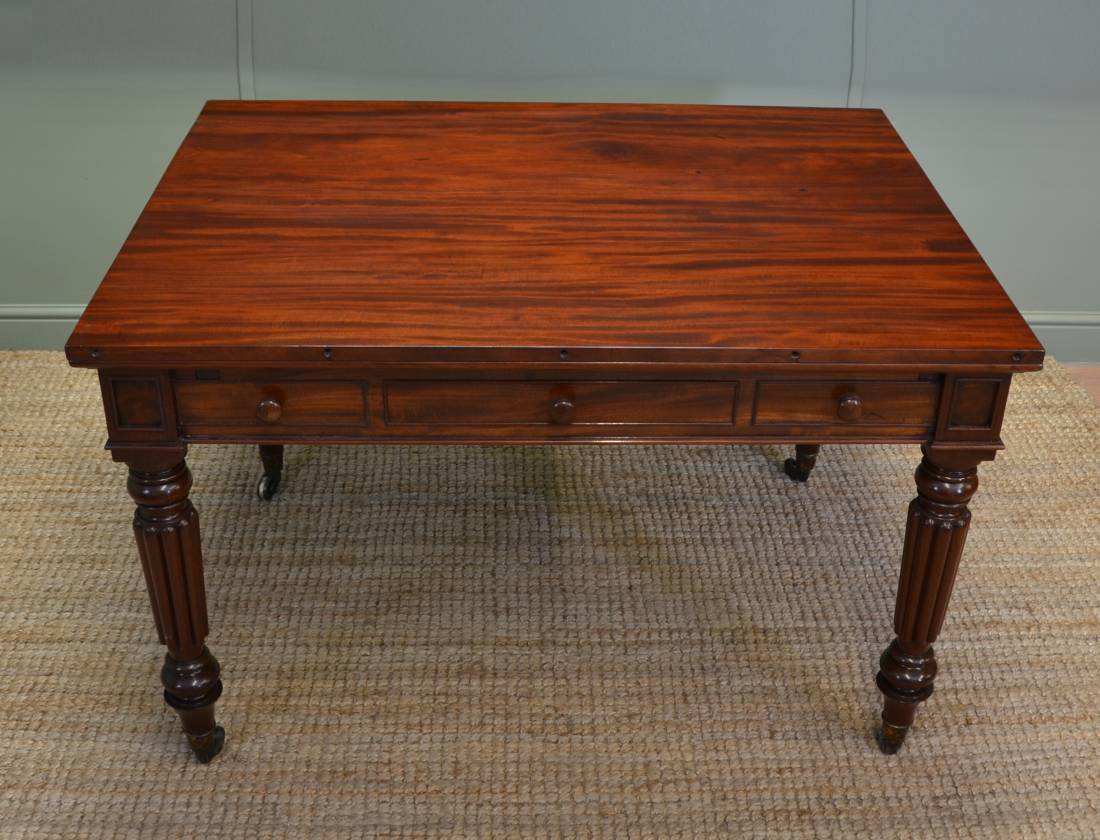
This Spectacular Gillows Mahogany Antique Regency Games Table has the most spectacular carved pedestal.


Almost Certainly Constructed By The Renowned Cabinet Makers Gillows Due To The Sheer Quality and design and date from around 1835. Each chair has a shaped back, elegantly carved with a scrolled back cross stretcher and stands on splayed back legs and beautifully turned front legs.
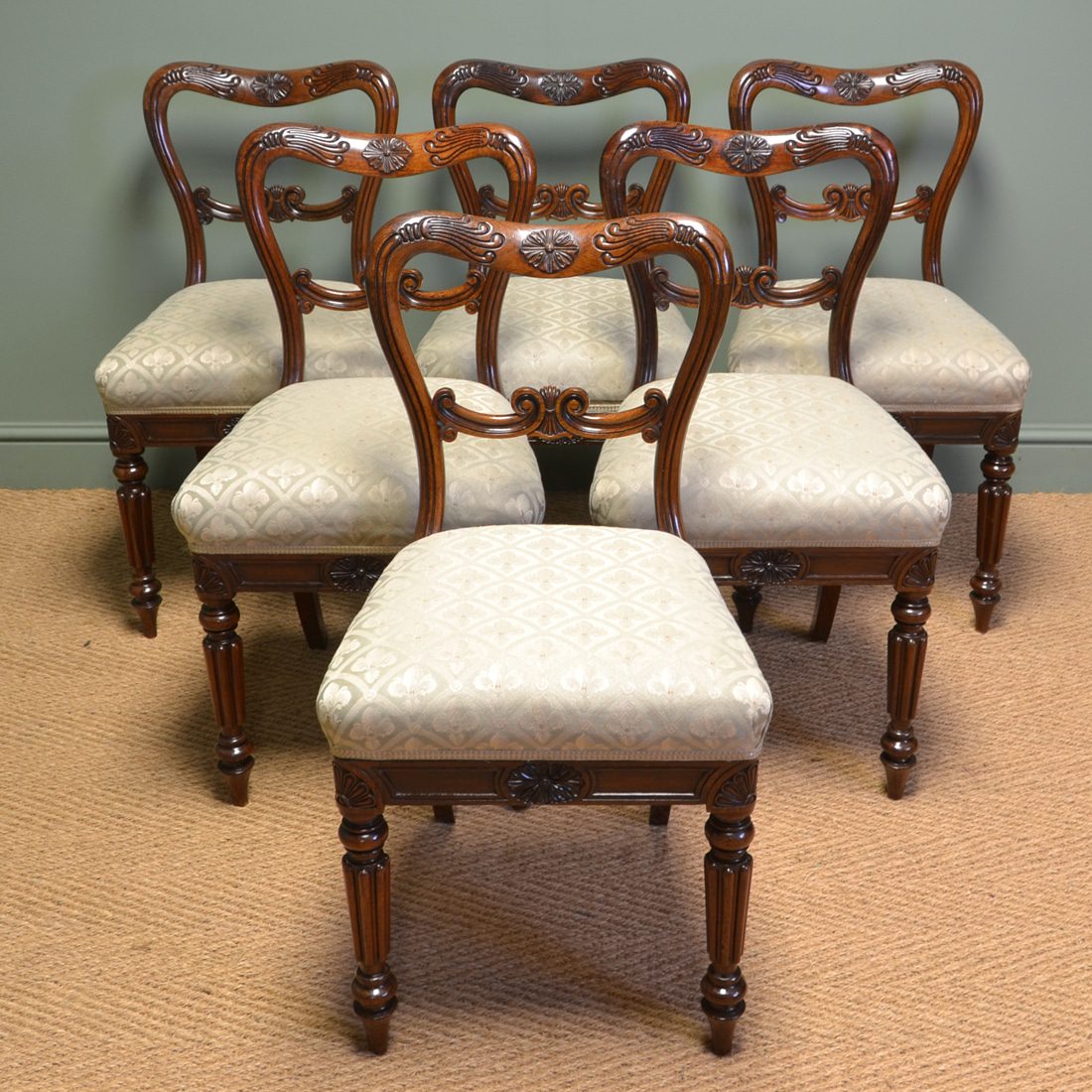
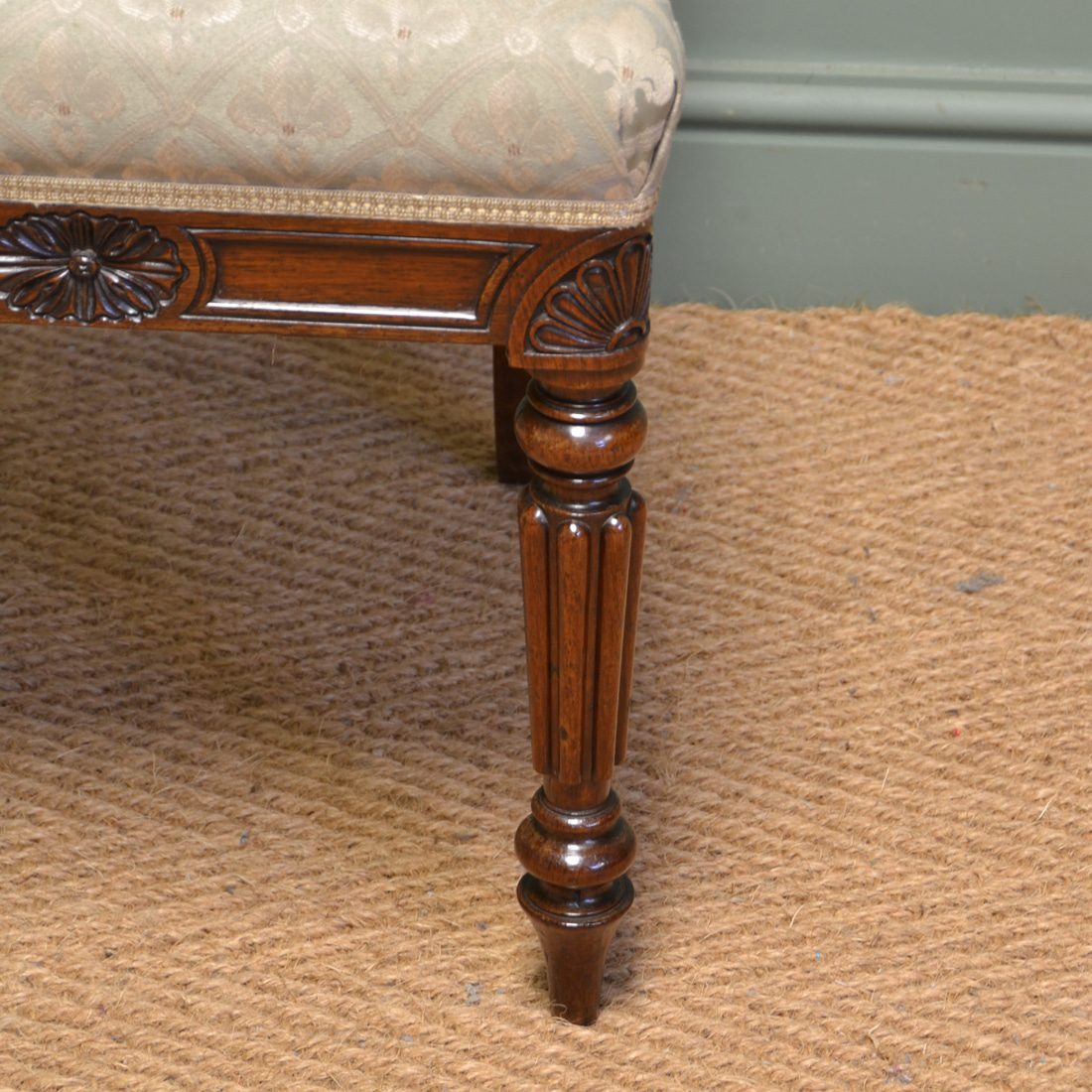
This Magnificent Quality Gillows Victorian Mahogany Antique Display Cabinet had stunning inlay and decorative brass detailing.
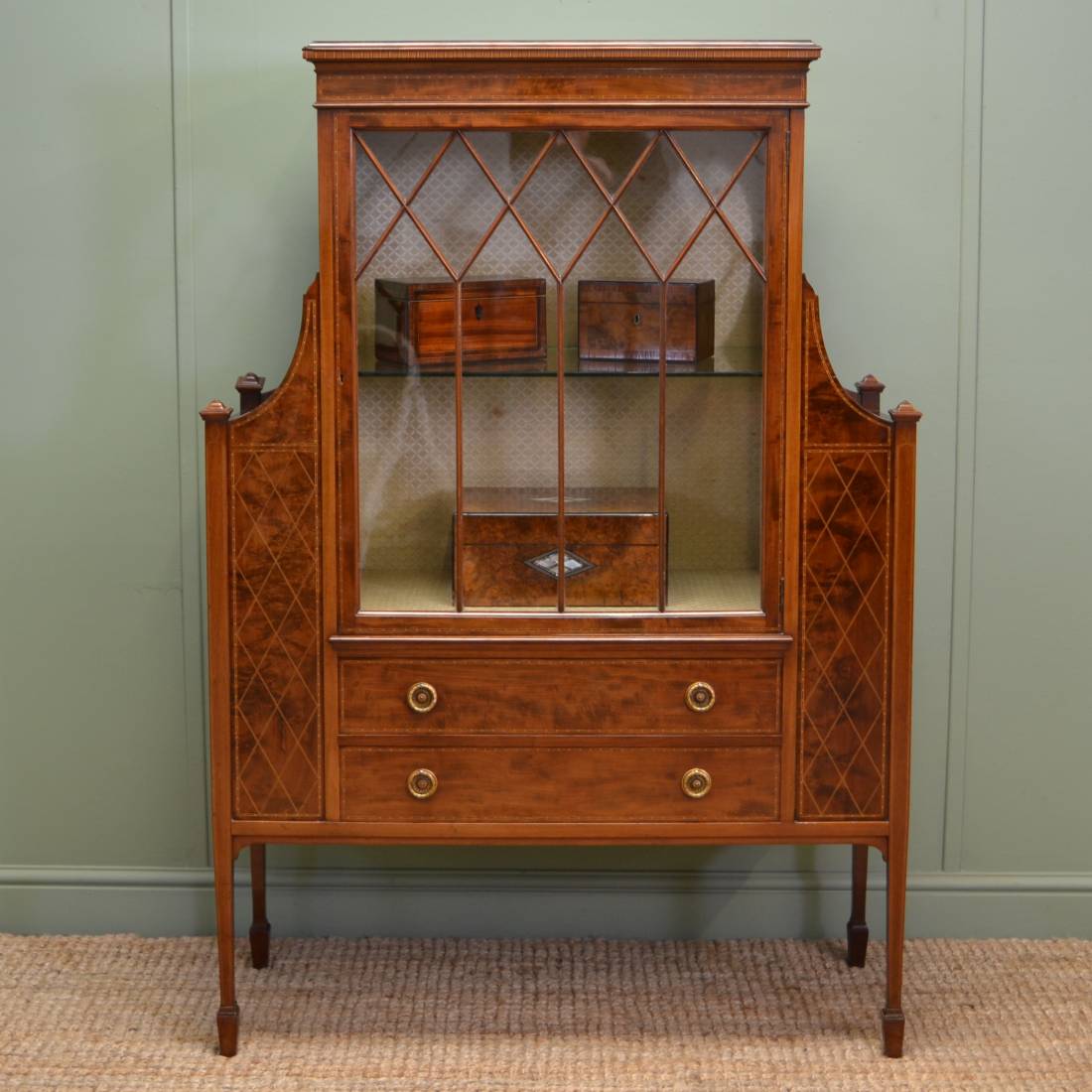
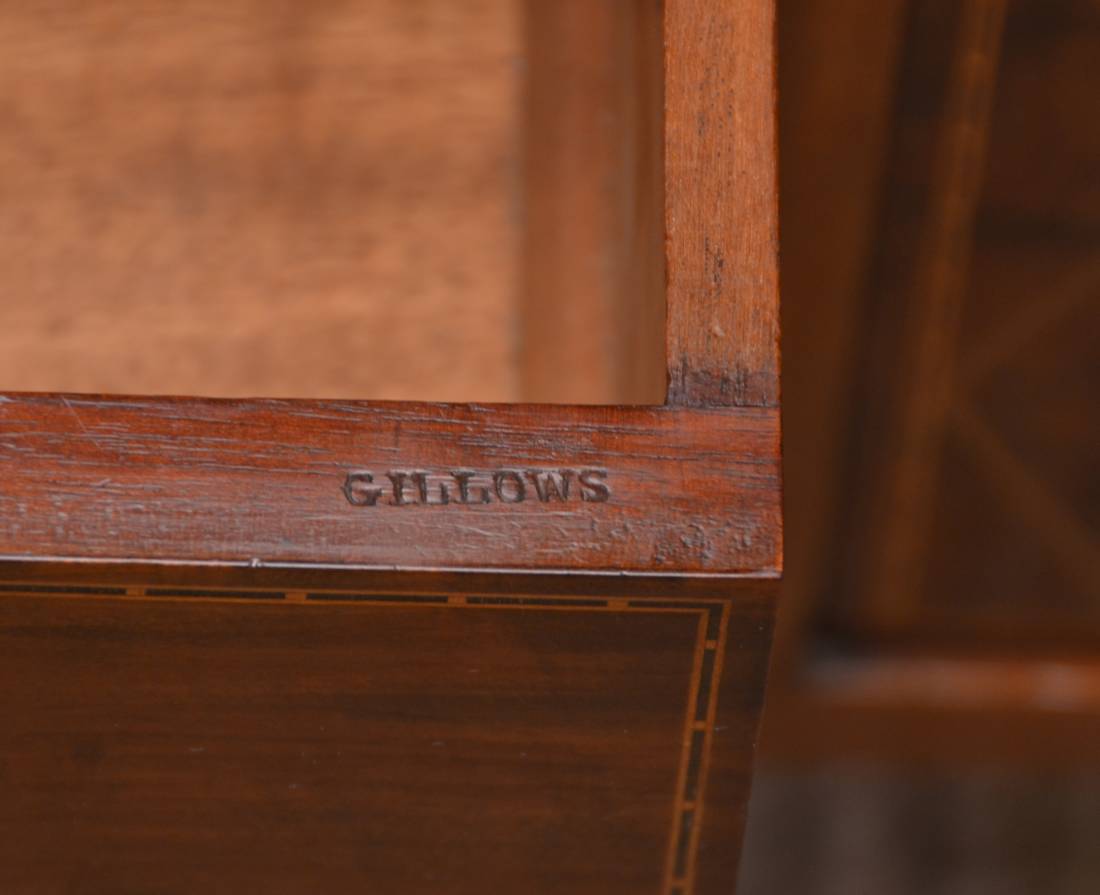
Constructed from the Finest Quality Mahogany Timbers and Attributed to Gillows, this Magnificent Georgian Gillows Antique Secretaire / Bookcase dates from around 1790. This breath taking antique has the most spectacular moulded swan neck pediment with fretwork carving and detailed carved rose heads, this sits on a moulded cornice with dental moulding.
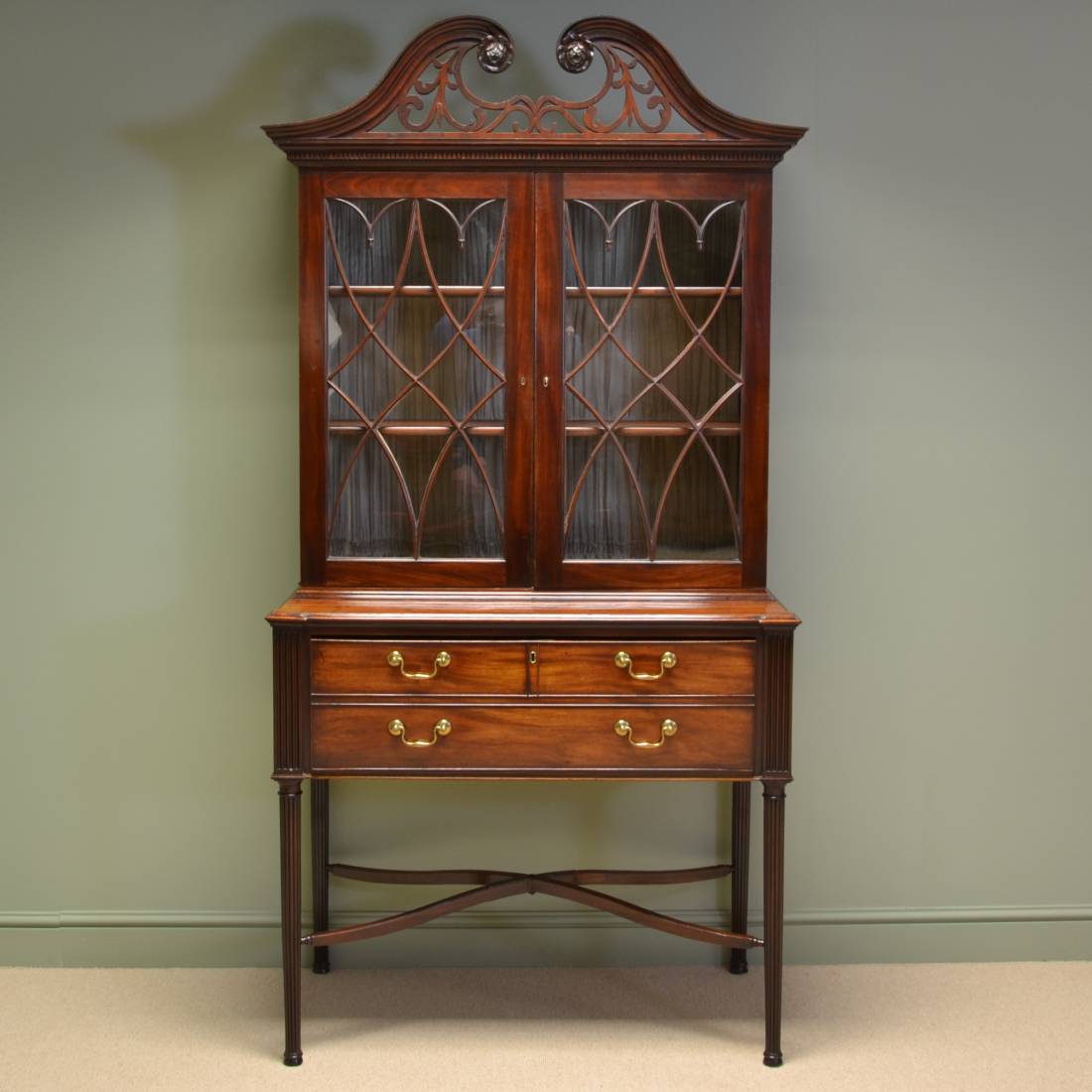
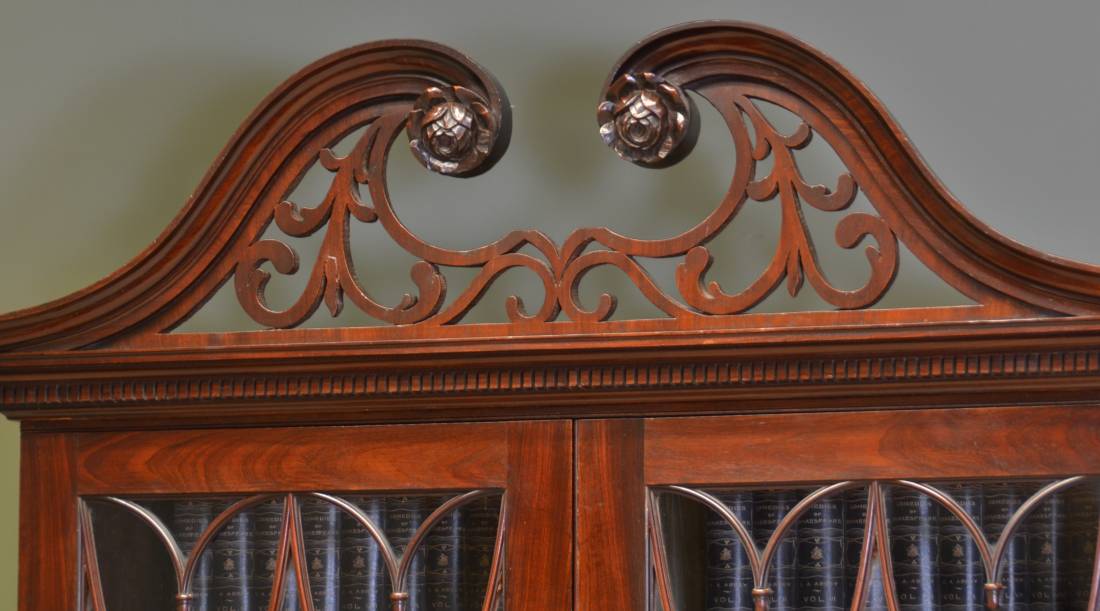
This Superb Quality Gillows Antique Bookcase / Cupboard was made from a golden solid Oak.
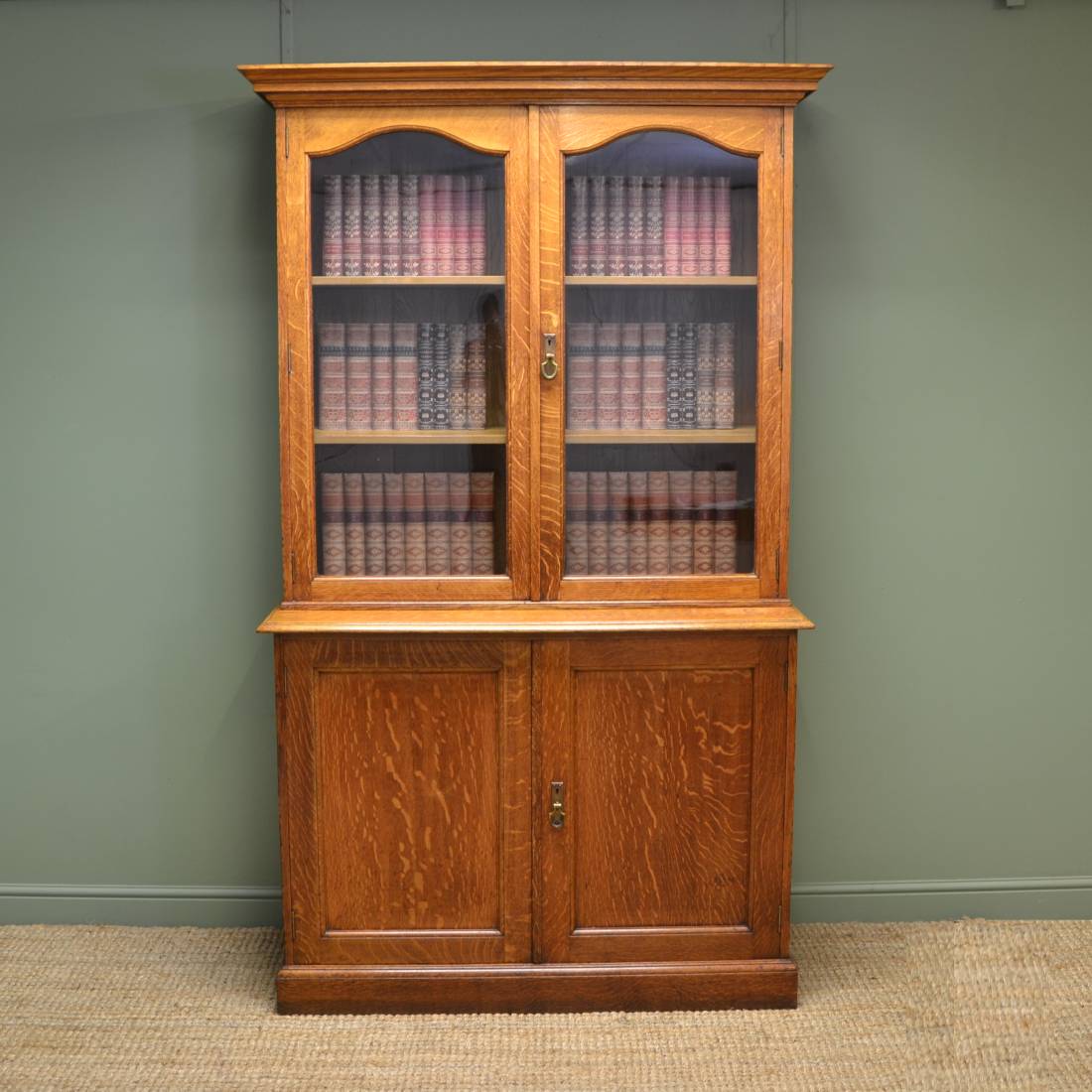
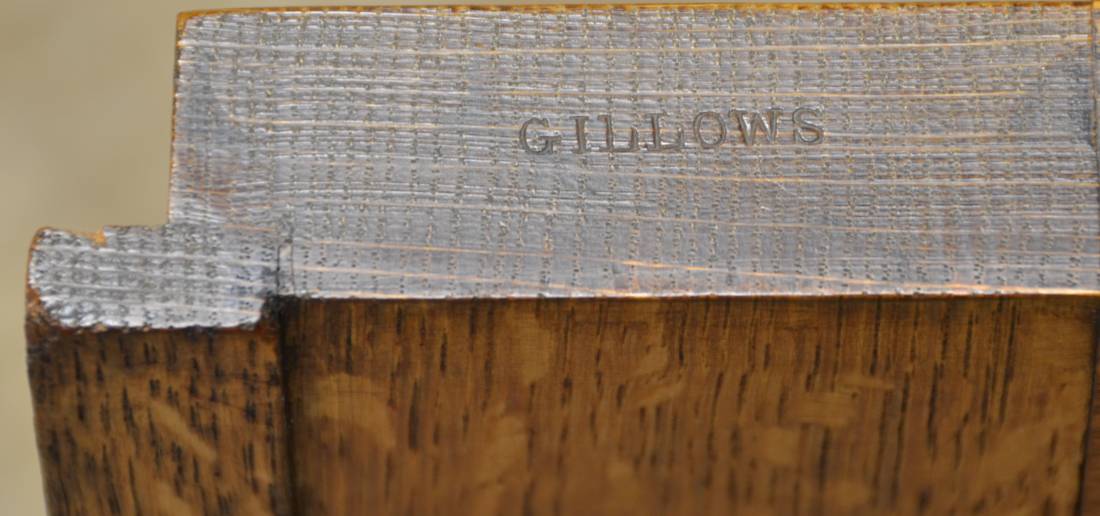
This striking figured oak bookcase dates from around 1850 in the Victorian era, with the most spectacular carved frieze.

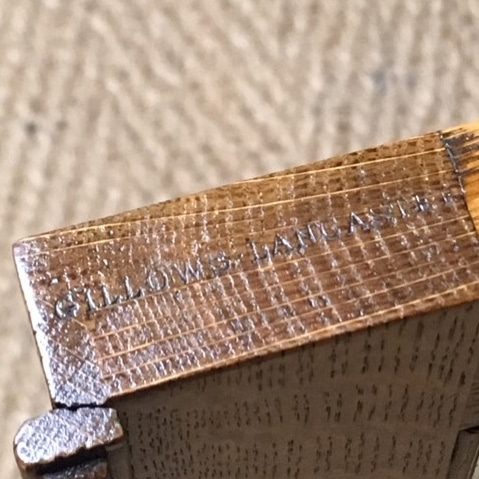
This late 19th Century Victorian Oak Writing Desk is in the arts and crafts design and constructed by the renowned cabinet makers Gillow & co ca. 1890. This superb Victorian antique desk stands on four beautifully turned legs and has a moulded cross stretcher for added stability.
This Quality Golden Oak Edwardian Antique Side / Writing Table has a tooled leather writing insert over an oak lined moulded drawer with brass drop handles.
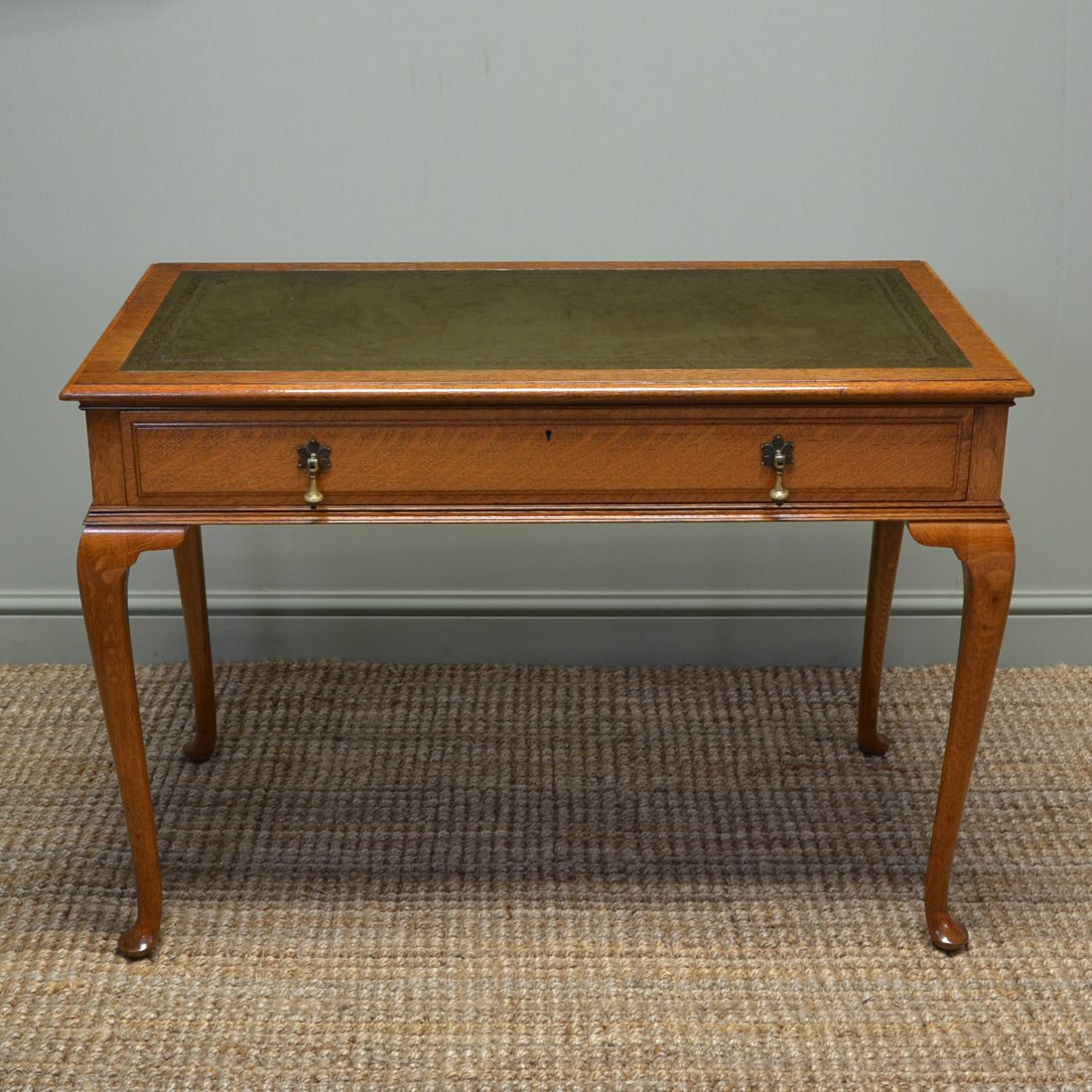
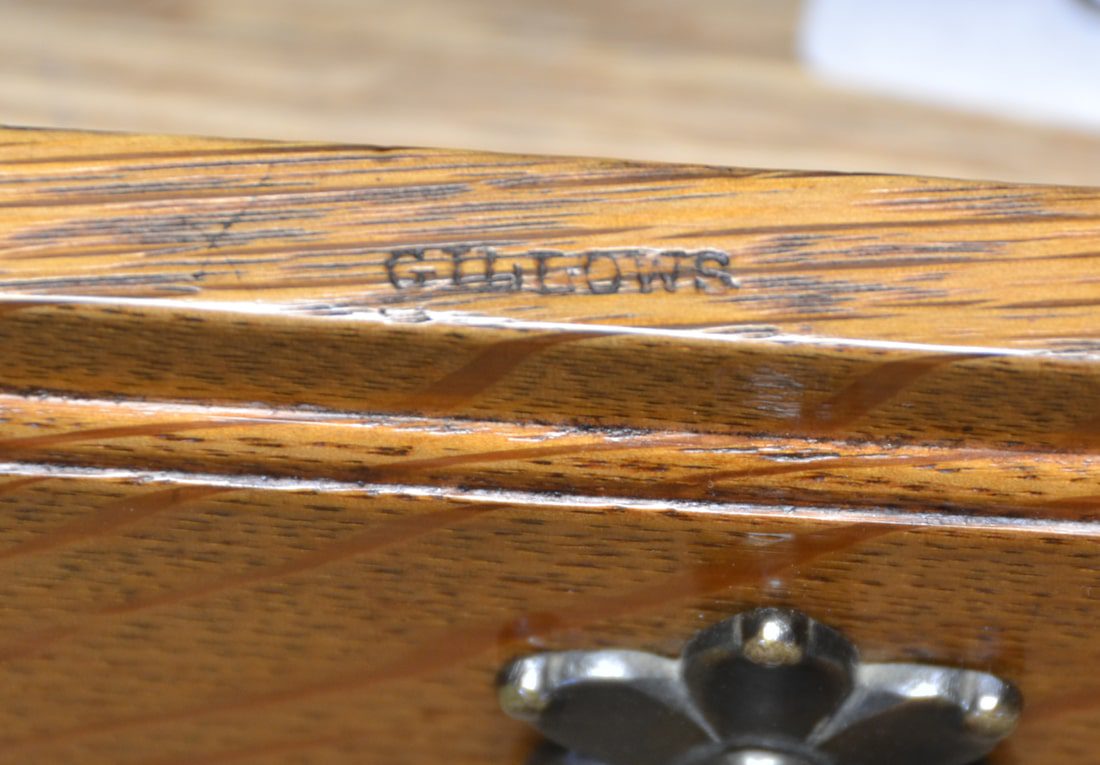
This Magnificent 19th century Pollard Oak Arts & Crafts Victorian Antique Cupboard is stamped Gillow & Co from ca. 1880. It has decorative floral carvings and simple aesthetic movement carvings and ebonised mouldings.

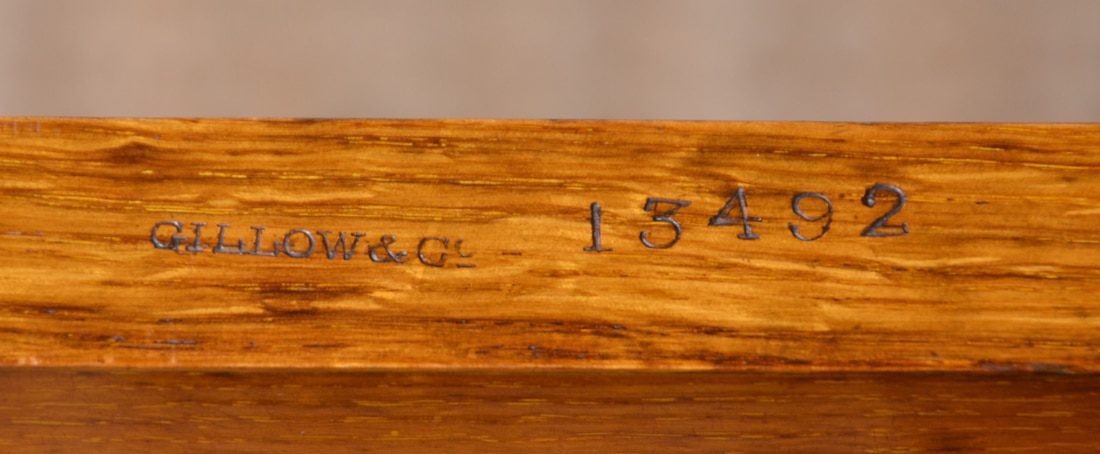
This wonderful hall wardrobe has a moulded cornice above a full length cupboard door with decorative carved panel and quality brass handles. The sides are canted and the interior comprises of a brass hanging rail and hooks and it stands on beautifully turned bun feet.

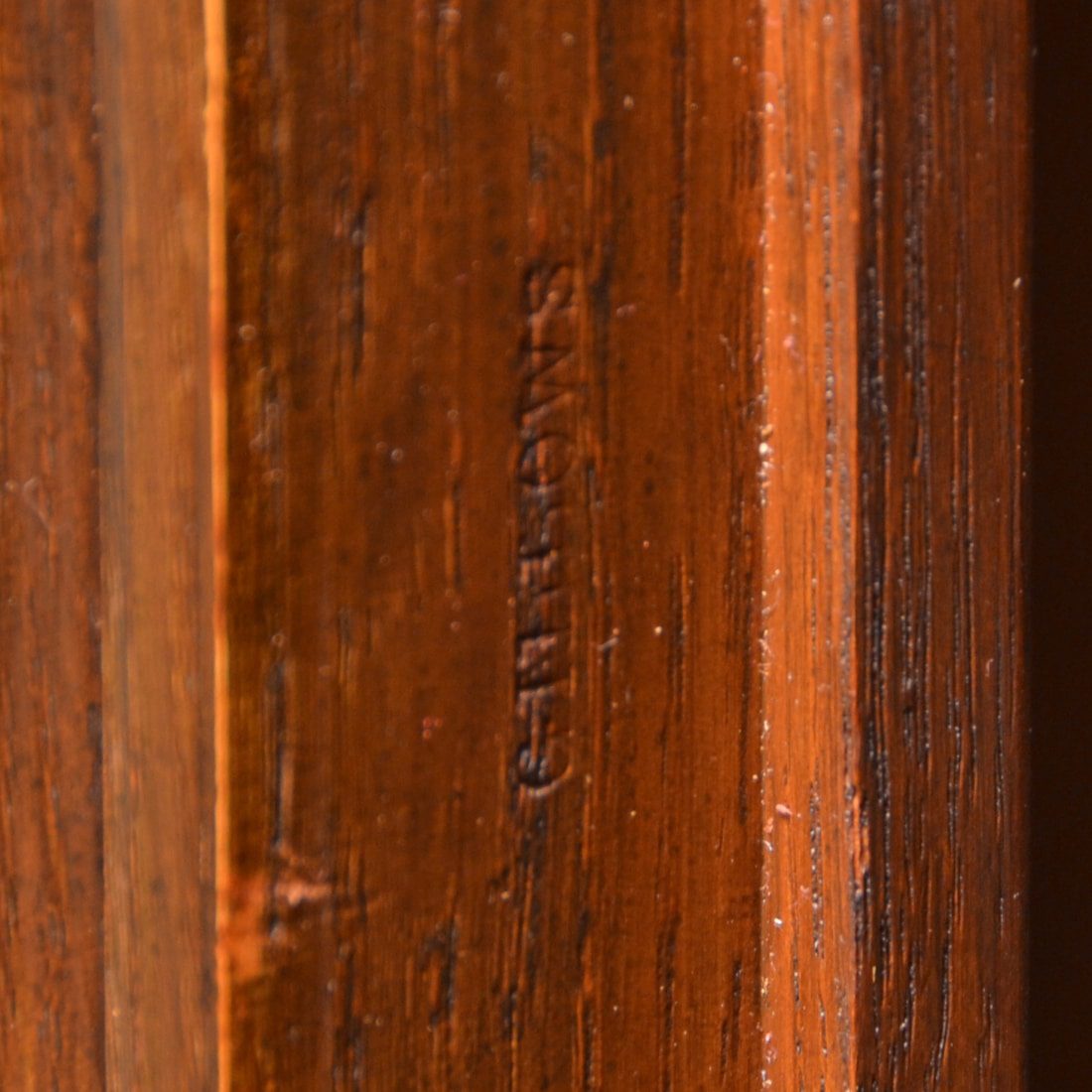
This Huge Edwardian Walnut Gillows Extending Antique Dining Table would seat 10 – 12 people. It has a beautifully figured top with moulded edge with 4 central removable leaves, winding handle and wind out mechanism.
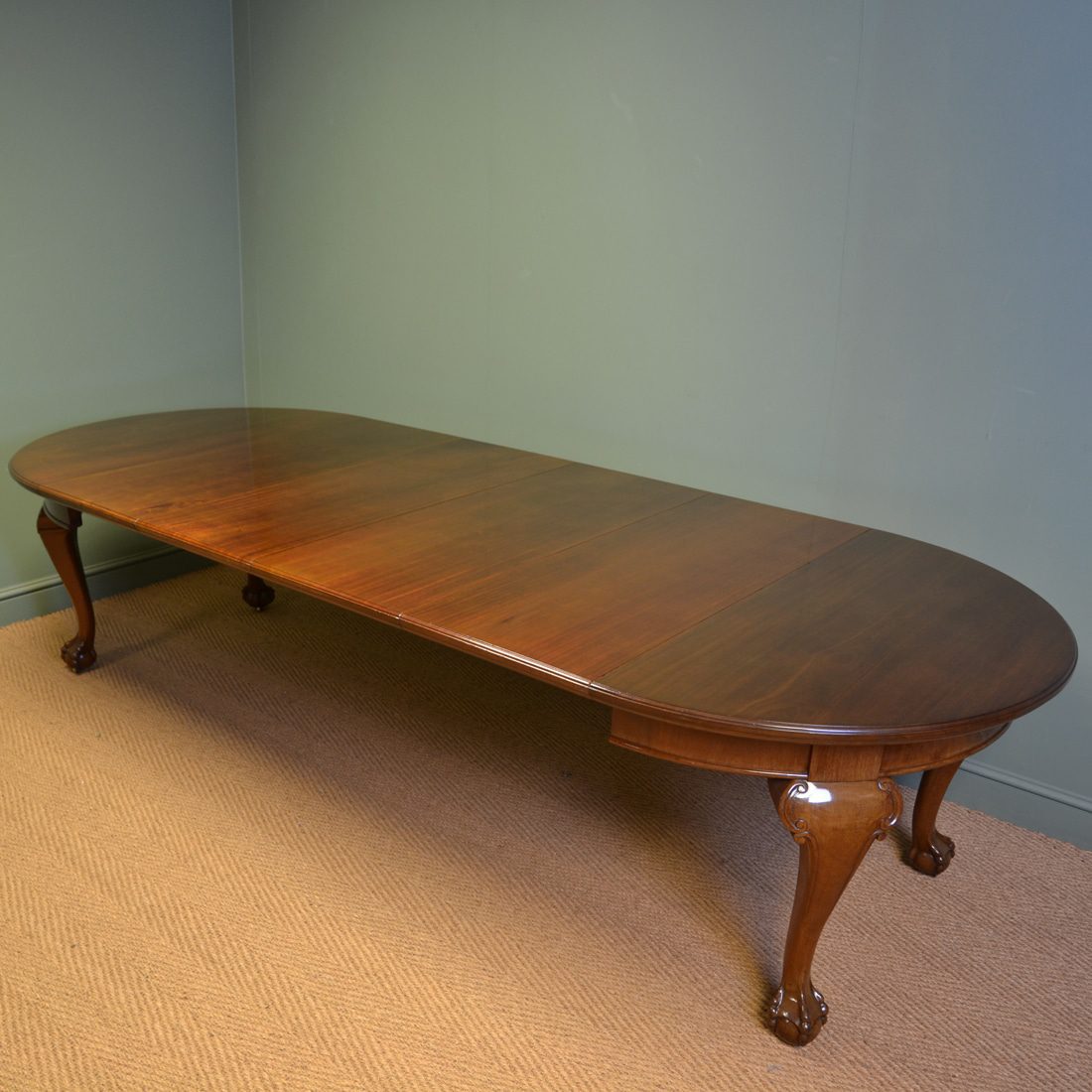
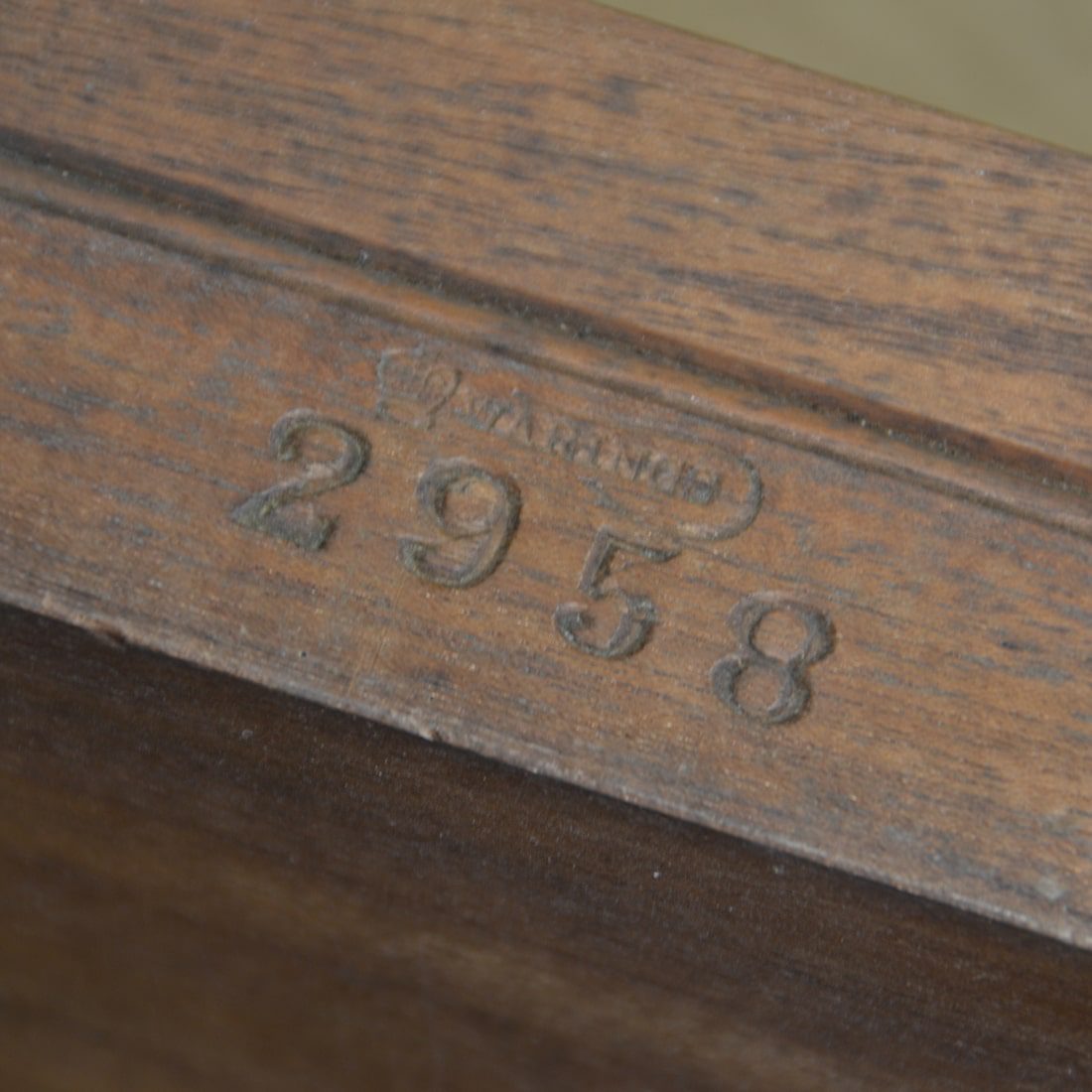
Later Waring & Gillows examples after 1901
This Quality Waring & Gillows Nest of Mahogany Antique Tables was presented from the Duke of Lancaster to Wor.Bro.I.E. Singleton.
This was a late example of a Waring And Gillows Antique Mahogany Small Glazed Bookcase but of a lovely design.
This was a Huge Art Deco, Stylish Antique Oak Dining / Board Room Table By Waring And Gillows
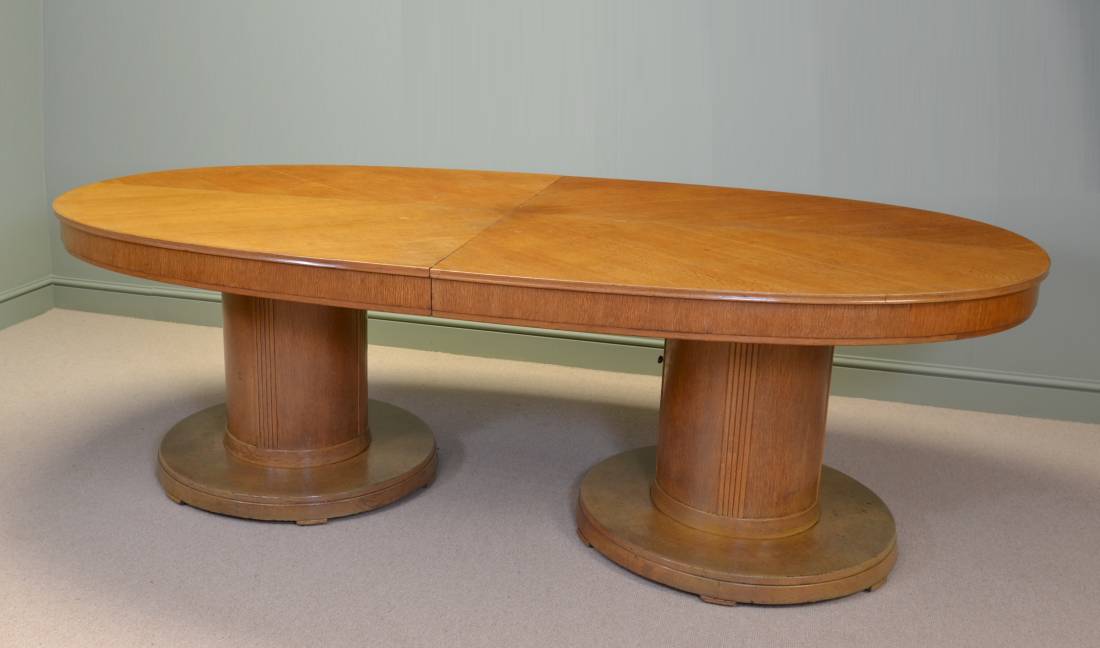
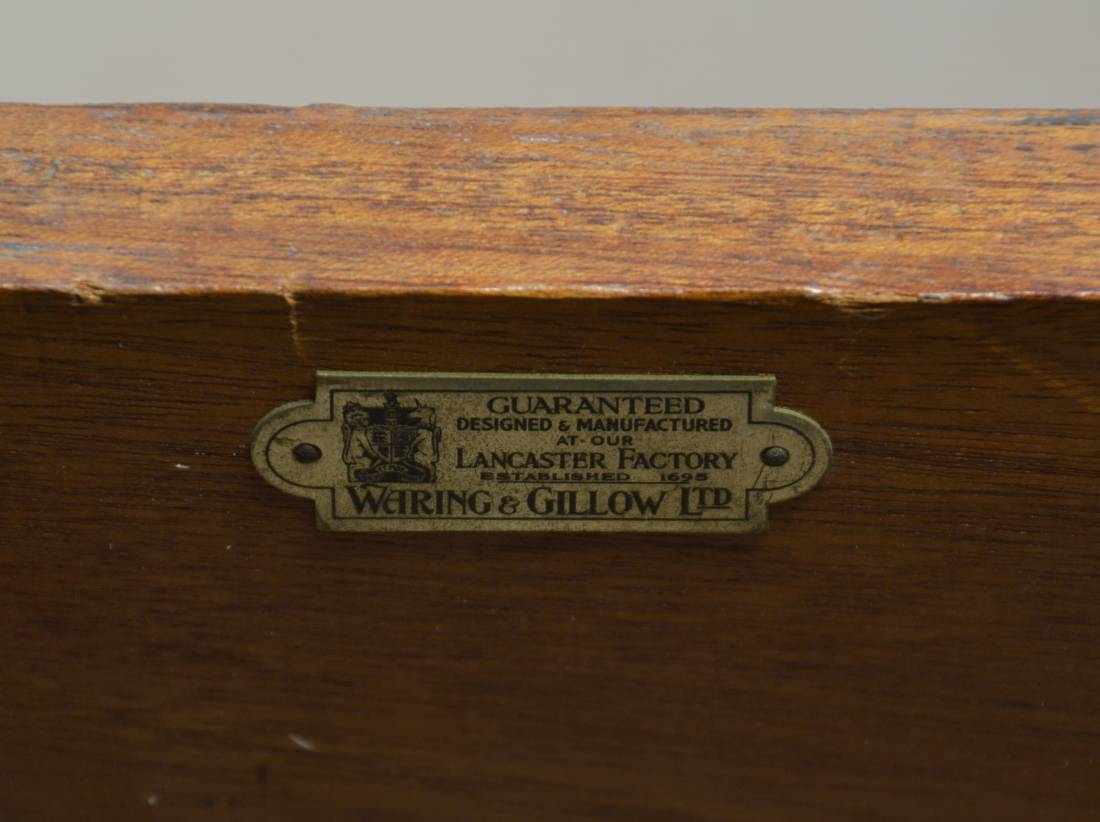
This Small Waring And Gillows Antique Walnut Decorative Occasional Table dates from around 1930, a really sweet small design.
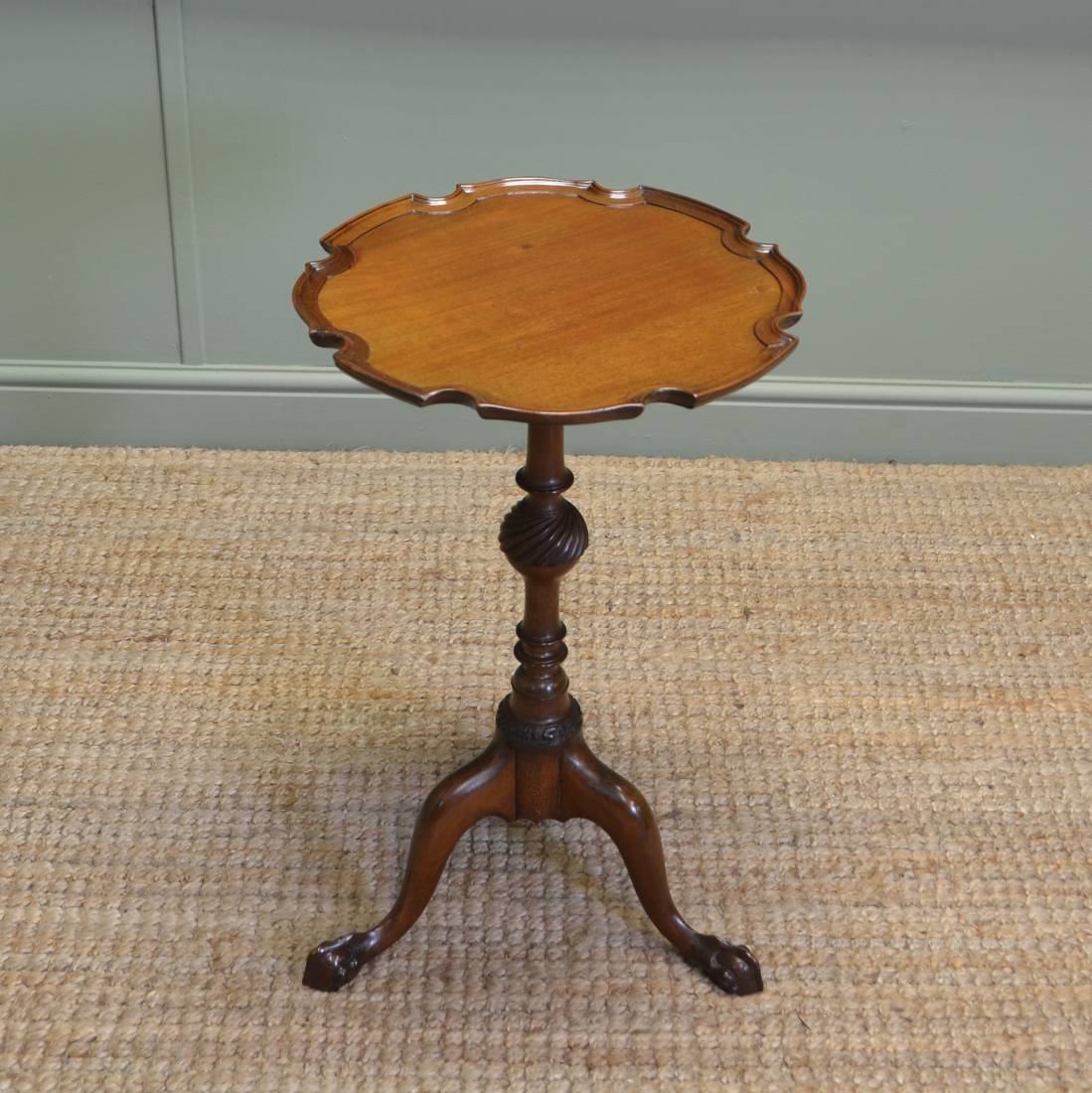

Waring & Gillow also made unusual shaped furniture like the Kidney Shaped in the the art deco period ca. 1930. This set consists of a dressing table with three hinged mirrors above a kidney shaped top with moulded edge and blind fretwork carvings.
This is an example of a S J Waring & Sons (Waring & Gillows) Oak Antique Revolving Bookcase has a beautifully figured top that sits above three tiers with moulded slats, ideal for storing all your favourite books, it also revolves three hundred and sixty degrees making it convenient to use and stands on castors.

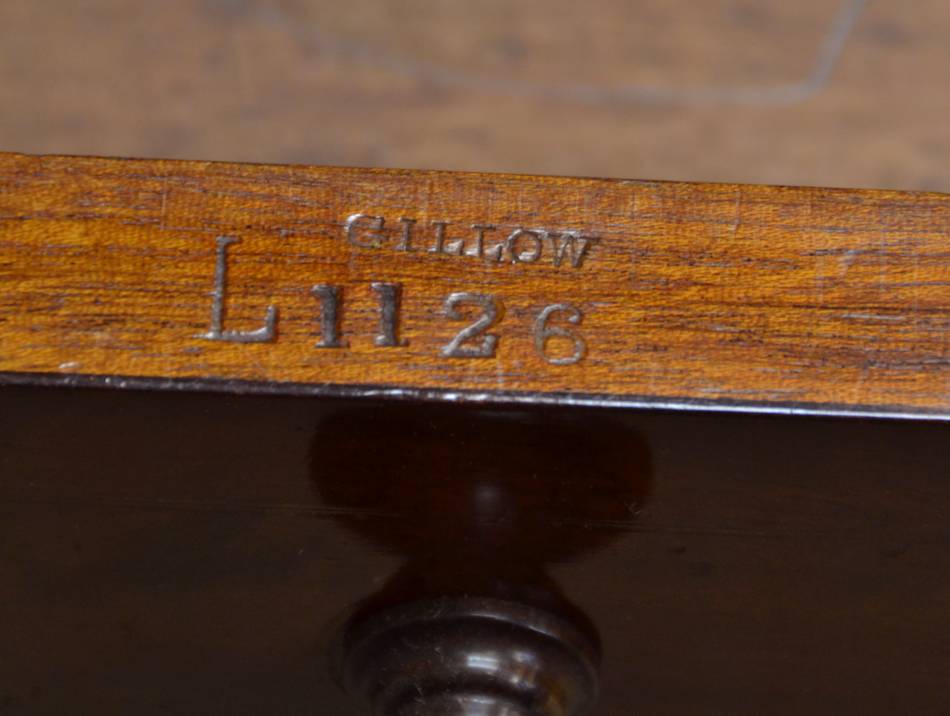
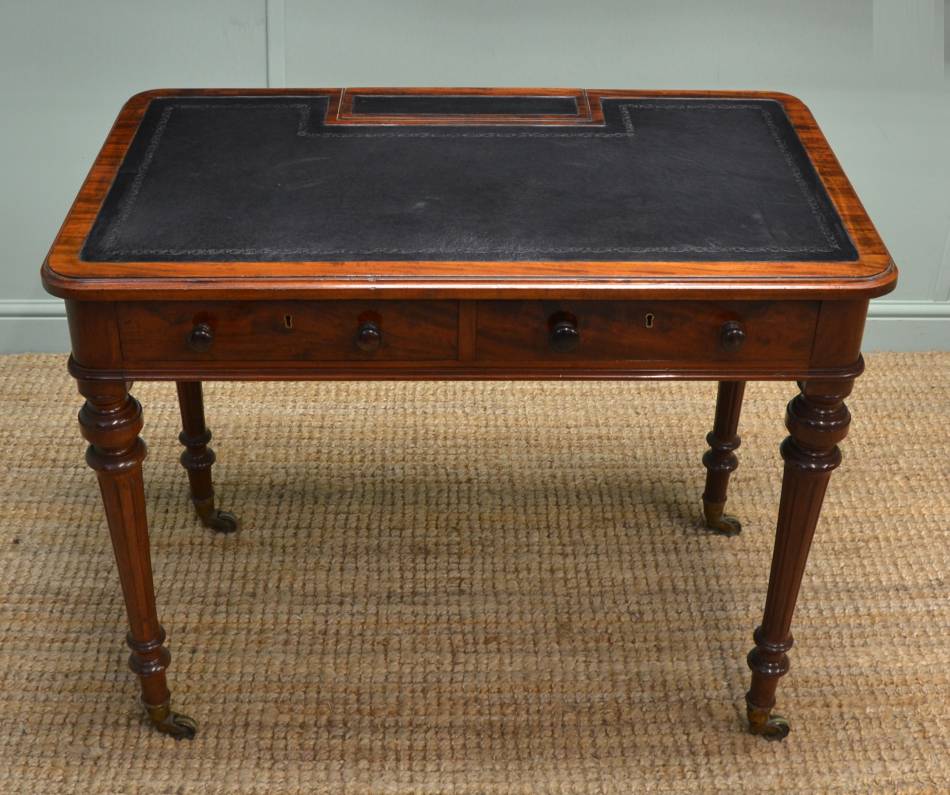

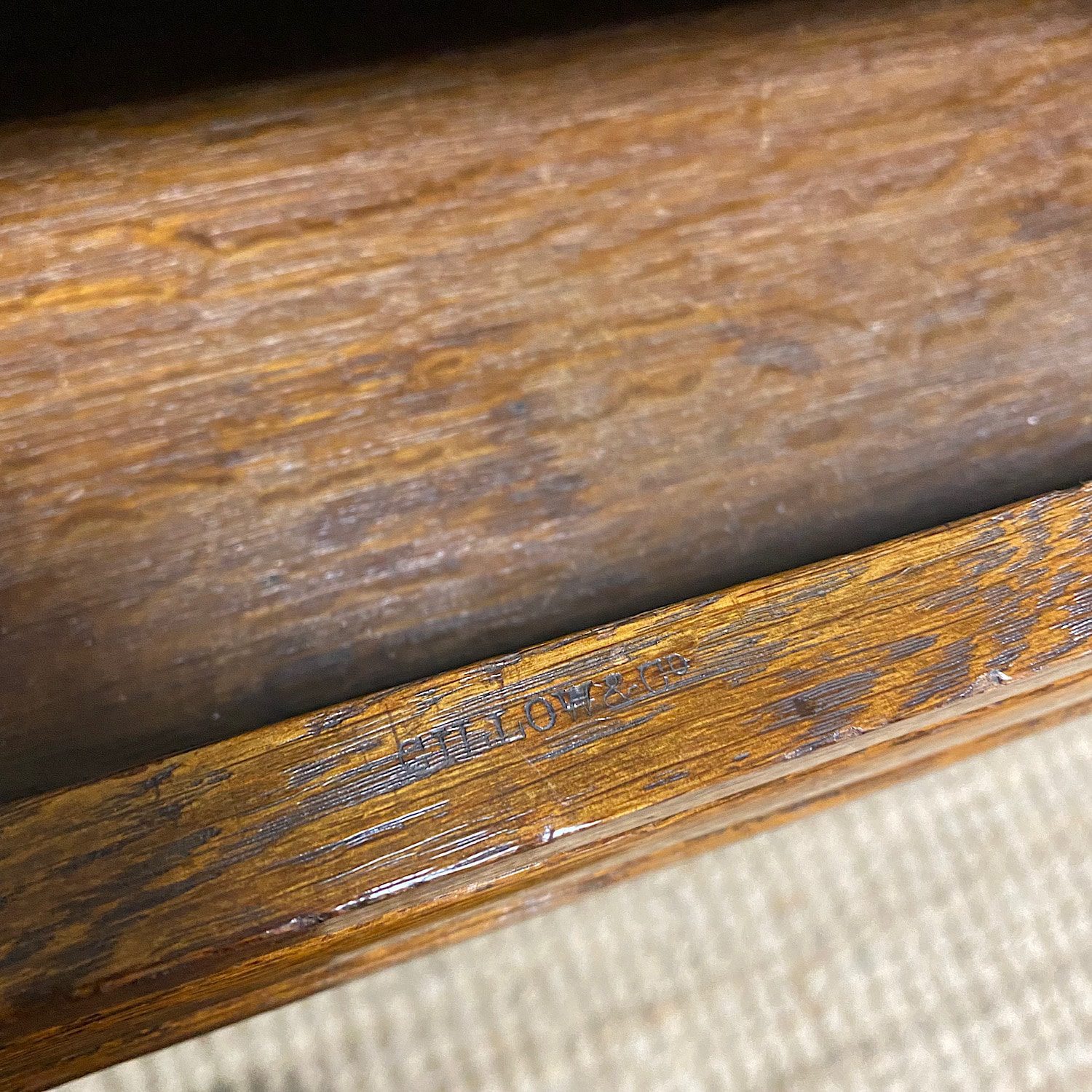


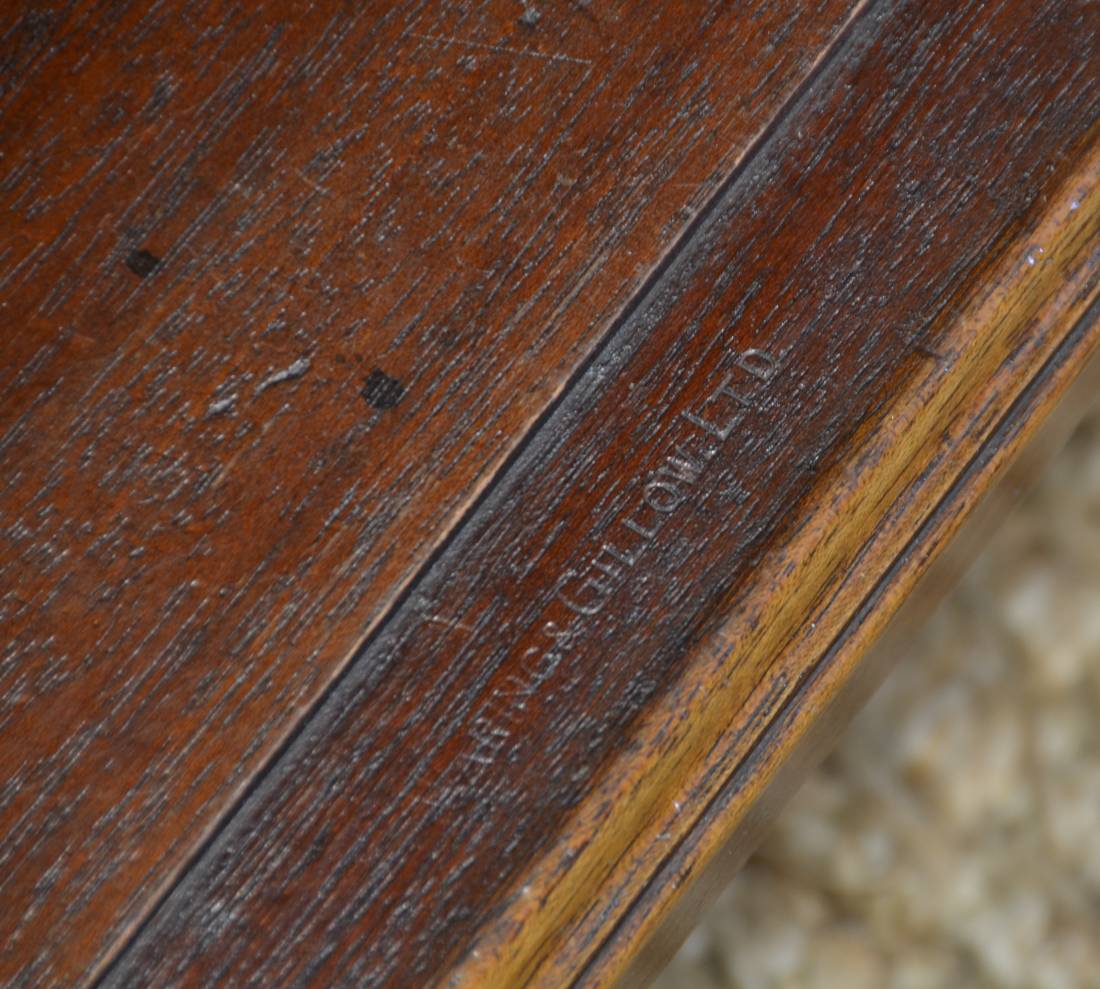

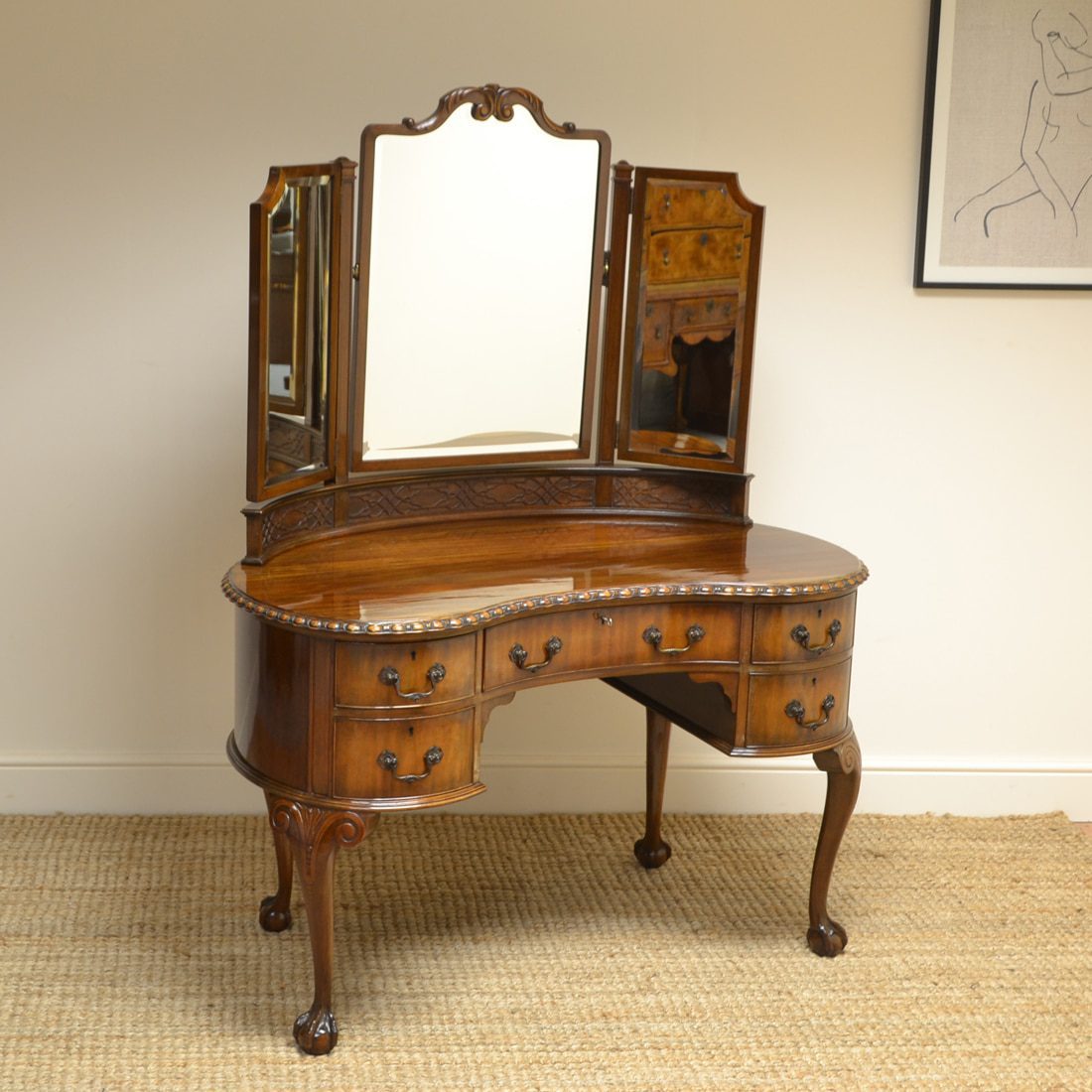
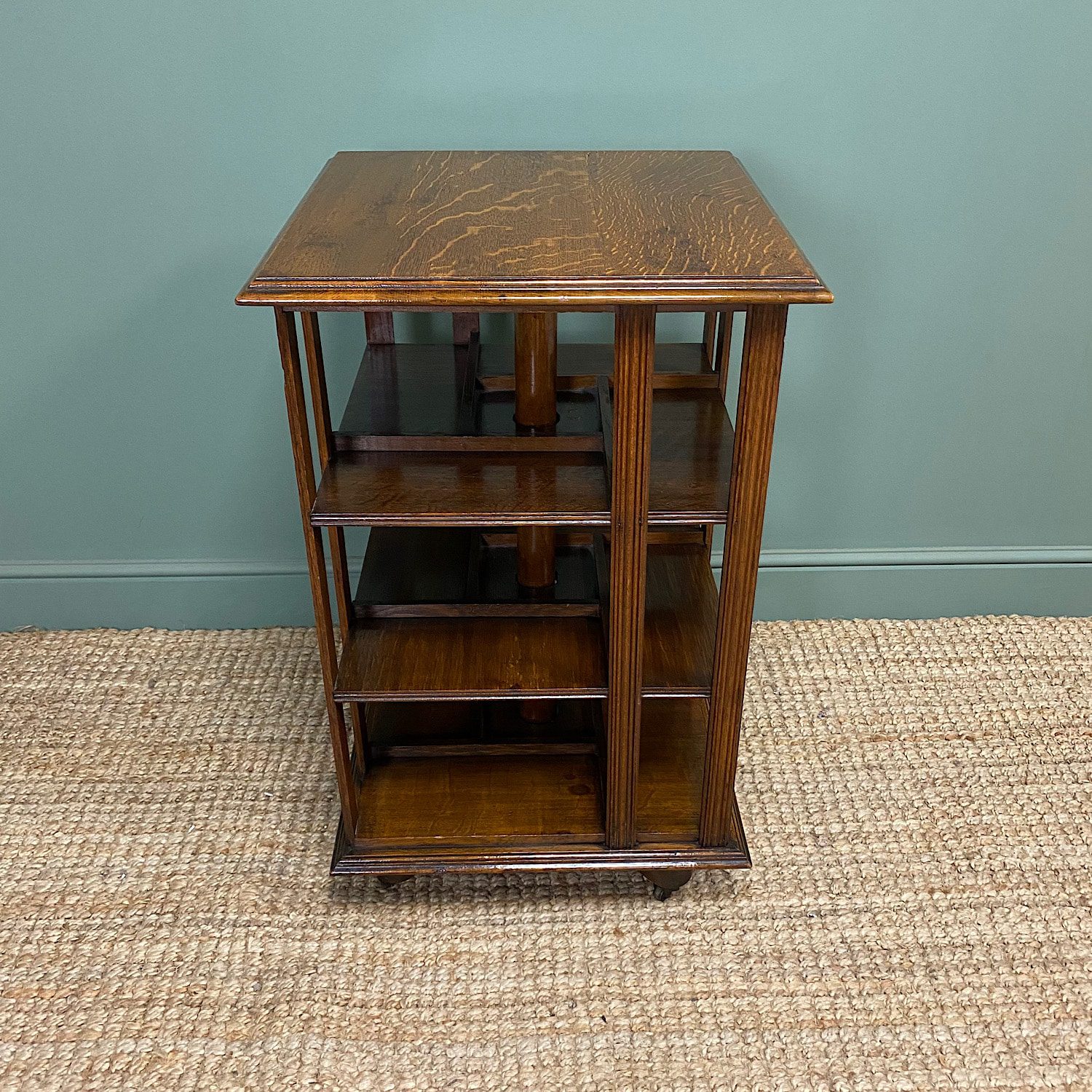
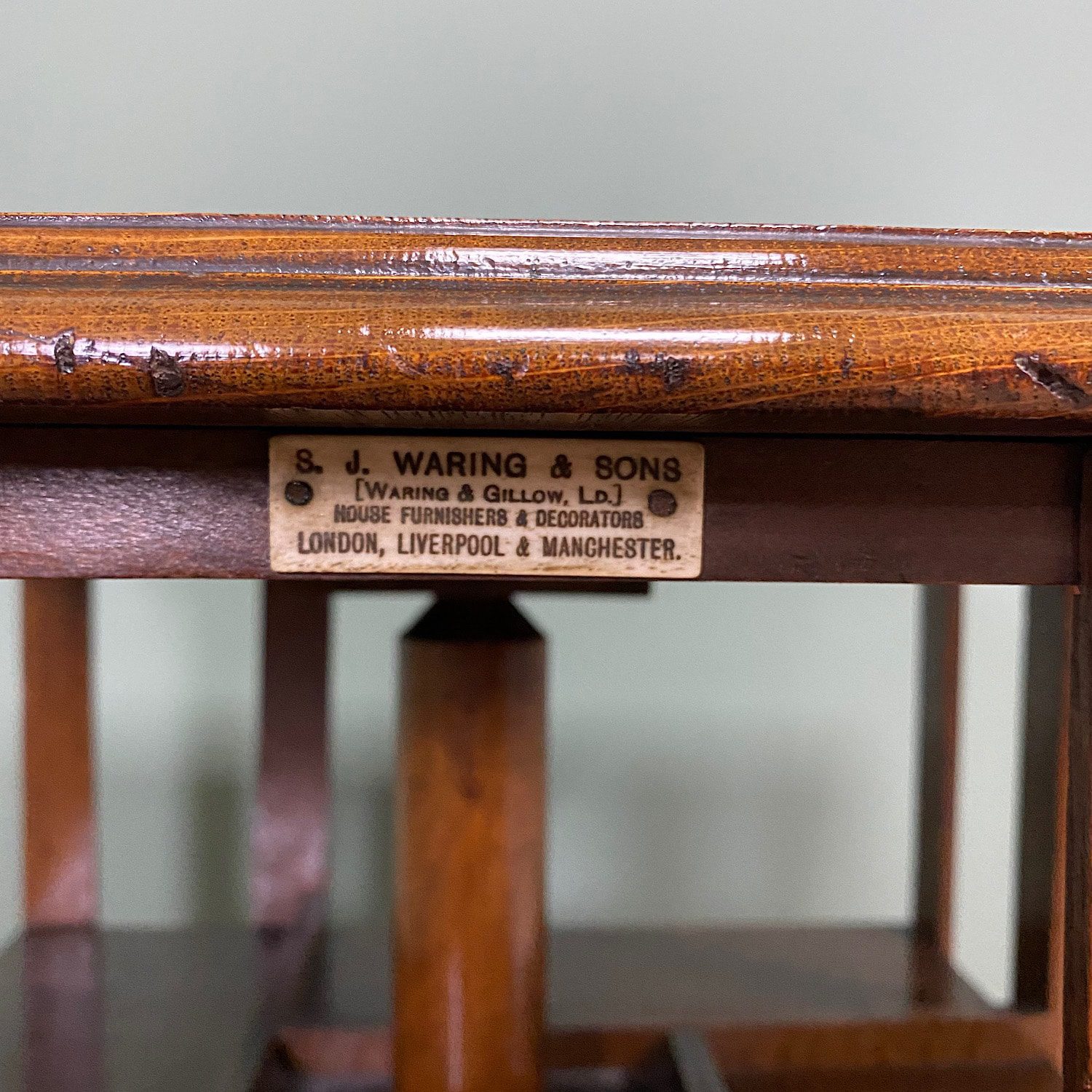
276 Comments. Leave new
I have a piece of furniture that I think is a gillows of Lancaster piece but no marks or a sign
Can you please help me
Hi
Gillows furniture was only stamped on around 30% of pieces, the best place to look is under any drawers or shelves for pencil signatures as this can be a good way to find the cabinet makers name who would sign there pieces after they built them. Once you find the cabinet makers name you can then look up and see if they worked for Gillows.
Kind regards
James
Hi I have a chest of drawers with a patent num on and the waring and gillows of lancaster plaque inside drawer how would I find out if worth anything
Hi
It will have some value being waring and gillows, but you would need someone to view it to determine the value as it will depend on the age, style and condition
Thanks
James
I have a small cabinet with drop sides with sign on warring & gillow where do I find value
Hi
If you just want to get a value then see our blog
https://antiquesworld.co.uk/valuing-antiques/
we have some helpful hints and tips
Thanks
James
I just got is what i truely believe is a true captians writers desk. I looked everywhere for a stamp. Couldnt find one. Well i was takong pictures of the piece all over. I flashed a picture of the hindges and screws and i seen this stamp. It looks like some letter and MW all together. Then theres a dimaond symbol with something in it. If anyone could give me some insight i would truly appreciate it. Its driving me crazy
Hi
Not sure on this one sorry
James
I have a piece of furniture –a knee hole desk which originally came from King Zog’s yacht(of Albania) which was sunk during D Day invasions.It is stamped WARINGS on all the drawers.Is it possible this was made before W&Gillow joined up and can you tell me anything about it.
Many thanks
Hi
Yes Warings did operate before joining with Waring and gillows so it will be an earlier piece
Kind regards
James
Hi
I have just been left 2 side tables one of which has a Waring & Gillows Ltd guarantee plate on it. It is solid oak (top is 3 boards approx 1/2″ thick) fluted legs, but a stretcher across the bottom is missing. Would this be worth getting valued? (ps I am in Scotland)
thanks
Hi
Yes they would be worth getting valued, especially if they are a matching pair as this is quite unusual to find. it really depends on their age to the value.
Thanks
James
I have a bookcase with a top shelf that can be tilted down. It has 4 shelves. It has a gold plate that says
GILLOW&Co
LANCASTER&
176 OXFORD ST
LONDON
Any info of when made?
Hi
With the stamp ‘Gillow & Co’ this would be on a late Victorian piece, maybe around 1880 – 1890.
I hope this helps
James
Hi
I have a large oak Waring & Gillows table (9ft x 4.5ft) with leather top. It has a Waring & Gillow (1932) plate attached and a number stamped on it, would you know if there is any way of researching where/who this may have been origionally made for?
Thanks in advance for any advice you can give.
Dawn
Hi
Unfortunately there is no real way to research this unless you have the original bill of sale or you can trace back where it came from by asking whomever you acquired it from
Kind regards
James
Hi, I have a large roll top oak waring and gillows desk complete with brass plaque. Not sure if it’s worth much but would like to see if I can get anything for it. Where is the best place to sell it?
Many thanks
hi
if you are local we can have a look for you and see if it is of interest to us
Kind regards
James
I have 4 dinning chairs stamped with the willows Lancaster brand under the chairs , there are no screws or glue used on the making of these chairs , would they have a value or date of production ? thanks Martin
Hi
Its difficult to say without seeing them in the flesh. maybe if you would like to send some pictures
Thanks
James
I have just bought a luggage rack which is stamped Gillows Ltd. O38655. Please can you tell me whether this is genuine.
I would be most grateful for any information you can give me.
Hi
Yes it probably is genuine with the gillows ltd stamp.
Thanks
James
Good day,
I have a chest of drawers a beautiful waredrope and dressing table with Gillow stamp that I want to sell who can I send fotos to or call
Hi
If you are local to us you are welcome to send pictures via email.
Kind regards
James
Hi I have 3 pieces as well could you send me a picture or yours
Hi
You can see examples of our previous Gillows pieces that we have sold on this blog page or if you are interested in purchasing Gillows furniture, please look at our current stock on our page
https://antiquesworld.co.uk/antique-furniture/
Thanks
James
Do all waring gillows furniture have a patent number on them as well as a stamp? I have several pieces of furniture which have the Lancaster factory stamp but also a patent number too, but others with just a factory stamp for Liverpool
Hi
Not all would have a stamp with Waring and Gillows, some would only have a patent number but always beginning with a capital L. I have seen others only with the Waring and Gillows stamp but the patent number is not visible until we have taken them apart for restoration and the stamp is on an edge that can not be seen when assembled. i hope this helps
Kind regards
James
I have acquired a vanity with the plaque that reads “Guaranteed Designed & Manufactured at our Lancaster Factory established 1695 Waring & Gillow Ltd” and patent number “224089”. It has been painted black. Will this lower the value of this piece? which is in 8 out of 10 condition.
Hi
Unfortunately if it has been later painted it will lower the value quite significantly
Kind regards
James
I have a dining table and 8 chairs (2 carver) made in cherry all of which we purchased over 20 years ago. Recently I had a fall and landed on the back of one carver. The front leg joints were unfortunately broken but everything else is remains intact.
My question to you is: do you /can you carry out a restoration on this chair?
If not , can you recommend a reputable company who may be able to help?
Regards,
JR Allen
Hi
We do offer restoration services, maybe if you can email me the pictures and I can take a look for you
Kind regards
James
Hi,
I have my Great Grandfathers Willow & Co pedestal desk. I believe it is made of Mahogany and is stamped on the top drawer L20174. Is it possible to date it from this number? I would love to know more about it as I believe it may of had additional drawers or something on the top as there are 4 holes on either side at the back. I have been using in my home office for the last 20 years and my wife hates it but unfortunately it’s the only family heirloom we have so I could never be parted from it.
Thanks in advance for any information.
Regards
Kevin
Hi
Thank you for your message, It is difficult to date without seeing it in the flesh but with the letter L, it was built in Lancaster and dates after 1860. If it is stamped Gillow and co it will probably be a late Victorian piece, maybe around 1880 – 1900
I hope this helps
Kind regards
James
Hi James,
Many thanks for the information.
Regards
Kevin
My mother-in-law has a very beautiful walnut kidney shaped ladies desk which is beautifully made and in almost pristine condition. It has the Gillow’s “look” but I haven’t taken out the drawers or looked underneath. It has a gilded rail around the outer edge of the top and small carved cartouches which are exquisitely executed and all different. There was a valuation years ago of £15,000 but I feel it is probably worth considerably more now. Any advice you can offer would be greatly appreciated.
Hi
For an up to date valuation I would recommend contacting a specialist auction house like Christies or Bonhams as the prices do fluctuate and some of the top end Gillows furniture has increased over the last few years but Gillows style is not as collectible as the purists only want genuine Gillows stamped pieces.
Kind regards
James
Hello
Just wondering if you could help
I’ve acquired a dresser with vanity mirror
It has a stamp saying ‘Warings Ltd Liverpool’
There are brass fixings with stamps ,these aren’t very clear at the moment as they are dirty.
We weren’t sure whether we should have the piece restored as there are marks on the surfaces and would like to find out more of the pieces history age etc
Many thanks
Gemma
Hi
If it is a Warings piece it would be worth while having it restored, but done correctly as bad restorations can devalue antiques. If you would like to send us pictures we can gladly offer a free quote for restoration as we can collect and deliver anywhere in he UK and we offer professional restoration services.
Kind regards
James
Hi, I’m trying to track the history of a dresser I have. It is stamped Gillow&Co L5925. Do you have any idea where I would be able to find out how old it is and where it came from? I live in Australia.
Thank you, Karen
Hi
Its difficult to track the history of Gillows furniture but It would have been built in Lancaster or London. Maybe if you would like to email me a picture and I can take a look at it for you
Kind regards
James
I have a Wooden Hexagon style shaped mirror with a scalloped style edging around it. It also has a Waring & Gillow brass plate attached to the back which says Guaranteed designed & Manufactured at our Lancaster Factory established 1695.
My husband remembers it hanging in his grandmothers house when he was a small boy.
Would it be worth anything as it has been in our loft for years and we would like to sell it if possible.
Hi
It will definitely have a value being Gillows, please visit here
https://antiquesworld.co.uk/valuing-antiques/
for information on valuing antiques
Kind regards
James
Hi there my grandmother would like to sell her gillows of lancaster Hall table it is stamped and i would like to know what kind of price she could get for this and where to sell it if you can help in anyway possible i would be very grateful. Many thanks
Hi
Please email us pictures and we can gladly take a look at it for you as it may be of interest to us.
Kind regards
James
Please can i have the email address many thanks
hi
its info@driscollsantiques.co.uk
Kind regards
James
Hi I have a pair of dining chairs which are bow type backed and quite plain and underneath they are stamped gillow and an indent carving h. doyle and also in pencil written A or perhaps J sanderson are they old and perhaps worth a fiew quid, the wood is good and solid but the upholstery is poor.
Cheers Robbie
Hi
They will have some value being Gillows but I would need to see a picture to offer more advice
Kind regards
James
I recently bought a horned gramophone at auction. I deal in thease machines and it is an obvious modern replica, however it carries a brass blaque which states that it was made in the Lancaster factory by Waring & Gillow. It has a very well made brass decorated case and original motor and horn. Is there any record of the company making such items. Picture available if requireds
Thanks.
John Sleep
Hi
I have never owned one but I have seen them before, you can see an old advert here
http://www.hatads.org.uk/ads/gallery/8153/537/Leisure-Equipment
Kind regards
James
Hi James. I have a Waring & Gillow beautiful small chair with rattan seat. It has the Lancaster brass plate and is numbered 76719. Would you be able to date and advise a value please? Thanks. Tony
Hi
Thank you for your email, for advice or valuations on antiques please visit the following link
https://antiquesworld.co.uk/valuing-antiques/
Kind regards
James
We have 4 oak dining room chairs all with the same W & G numbers.
We also have a Carver chair with a different number.Who could we sell them to please?
if you are local to us we would gladly take a look at them or alternatively I would try a good antiques auction
Kind regards
James
Hello, I’m not sure if you will be able to help me but I am trying to find out about a furniture maker Shepherd & Hedger Southampton, Salisbury & Dorchester. I have a beautiful solid oak display cabinet, and cannot find anything about them on the internet other than it is possibly 1930’s.
Hi
I have seen a few items in the past by this maker, usually 1920s to 1940s pieces but unfortunately I do not know of any information about this maker.
Sorry I can not be of any more help
Kind regards
James
I have found out that Shepherd & Hedger were taken over by Maple & co!
My late mother, widowed when I was one year old, was courted for a time by Frank Hedger! Shepherd and Hedger had a shop in Above Bar, I think, in Southampton, and another in Salisbury. I never heard of the Dorchester one until recently. The company did the furnishings for Lord and Lady Docker, who owned the (then) super yacht ‘Shemara’. https://www.edmiston.com/yacht-charter/yachts/shemara . My brother still has carpet in his house that was taken off the yacht when Lady Docker wanted it refitted. Frank Hedger gave my mother a pair of Queen Anne style chairs by Parker Knoll. However he bought the frames and his own men made up the chairs, upholstered with the off cuts from Lady Docker’s hand embroidered dining room curtains! The partners had a holiday home in Capel Curig, N. Wales, and we spent at least two holidays there (I was only a small boy then, seven the first visit, so 1960). Frank Hedger was single, although he had, at some stage, been married. He had three cars; an Aston Martin, a Jaguar, and a Rover 3L, the day they came out. However he used to go to work on the bus as he could get a bus from outside his house to either of the shops!
Hi
I have been offered a leather inset games table around one yard square with pull out drinks coasters and am being told it is W & G. I can find no marks (I note your 30%m only marks above) but it is stenciled ‘Heritage’ on the underside. Is it possible it is W & G? THanks, Brian
Hi
It was only the earlier pieces that was not often stamped, all the Waring and Gillows pieces were stamped
Kind regards
james
I have a chest of drawers that has Waring and Gillows ltd imprinted on the drawer edge and a patent number plaque which says PATENT 224089 and a brass plaque that says Lancaster factory. Are you able to give any dates for this.
Hi
If you would like to send a picture, I can gladly have a look for you but I would say around 1900 – 1920
Thanks
James
Hello
I have a similar piece which I bought 14 years ago and still use every single day, however I am shortly moving and looking to sell it. As in your previous message may I post you photos
Many thanks
Kristine
may I add that I would really like to know about it, my partner and I having spent hours searching are so please to come across your informative site
Hi
You would be welcome to send pictures and i can see if it is of interest to us
Thanks
James
Hi there –
I have 2 chairs which underneath the seat are the carvings ‘G&T’ – I know my (husbands) Grandfather & forefathers were ‘Cabinet & Fancy Cabinet makers’ in London & worked for Gillow’s.
I wonder if you could tell me more on the chairs as to whether they are early ‘Gillows’ – plus there is a large Mahogany Chest of Drawers which I cannot see a stamp/carving but there is a pencil writing of name & possible address but as it is pencil its very difficult to read. I do have pictures if required.
Many thanks,
Val
Hi
The G&T may be the cabinet makers initials but i do not think it would be Gillows, I think there was a cabinet maker in London who used G&T on there pieces of furniture. I would need to know what the name is under the drawer, usually if it was a cabinet maker for Gillows they would sign it with their name.
I hope this helps
James
This is a really interesting site, thank you.
I have a sideboard, marked L79488 and marked TI under the drawer. It has a warning and gill of made in Lancaster plate inside the drawer and an incomplete paper label on the back of the raised back stand. There is also a patent plate nailed into the drawer 27978. The only sideboards I can find under the patent number have three drawers and are listed as 1920 but this sideboard only has two drawers.
Can you assist in dating it for me please?
Hi
The best thing to do would be to email me a picture and i may be able to help better
Kind regards
James
Hi, I have a writing desk with inlaid wood and tapered octagonal legs. I think it might be Engkish Oak but not sure. It has two hidden drawers along the front and two other drawers above. It is stamped “Waring & Gillow Ltd” on the top edge of one of the hidden drawers. The back is unfinished. There is a paper label affixed that says “Ship No. 729 (I think) Cabin De Lux No. 111 C1091”. I’ve owned it for about 20 years. Any thoughts you have towards origination and value would be most appreciated.
Hi
It must have come off a ships liner so this will be very collectable. I would do some research into the ship as this will add to the value if you know its origins. I know Waring and gillows did furnish some very good ships so it will be a quality piece but I am unsure how you would find out what ship it is, maybe try a maritime specialist.
Thanks
James
Hi – is there a way of dating Gillows furniture from the number stamped on? (15276 on a lamp table), had a quick Google thinking there may be a register of sorts but can’t find anything.
Thanks
Unfortunately there is no register, there is some good information in the gillows books that may be able to help you as they list many cabinet makers names and some numbers
Thanks
james
Hi
Just after a little advice.
I’ve just bought a lovely if a bit unusual oak draw leaf table.
After having a closer look it’s got a brass plaque with wearing and gillows and a set a patent numbers.
I can’t see any other markings on the table.
How could I find out more about the table ?! Dates of being made etc ??
Thanks in advance
Hi
for advice Please see
https://antiquesworld.co.uk/valuing-antiques/
they offer a really good service on advising on dates etc.
Thanks
James
Hi
Would it be possible for you to give some advice.
We have a Waring & Gillow dressing table. We wondered when it was made and what the value would be as we are interested in selling. The patent number is 224089. It also has a metal badge stating made in Lancaster factory.
Kind regards,
Jan
Hi
we do have an interesting article to help people who are looking for valuations of antiques
Please see
https://antiquesworld.co.uk/blog/valuing-antiques/
for hints and tips
Kind regards
James
Hello,
I have a walnut desk that is stamped Waring & Gillow, Brussels. Do you have much information on furniture produced from their Brussels manufacturers? I’d like to try and date the desk. I also need to replace a lost key to fit the locks in the 5 drawers. The design includes cabriole legs, leather inlay on top and a custom glass protective top, and rounded corners. However, the two drawers on left and right, along with the longer center drawer seems to be traditionally edwardian in style.
Thank you,
Marianne
Hi
I know if it was from their Brussels department it will be dated from after 1906 so may be a late Edwardian piece but with cabriole legs may be as late as 1930s
I hope this helps
Kind regards
James
Thank you, this is what we thought as well. Now, if you could advise us on how best to obtain a key for the drawer locks we’d be ever so greatfull. Can locksmiths make a key to fit these old mechanisms. They are made so well. Or is there any way to order one? Thank you.
Hi
A good locksmith can cut keys for these locks as they can be quite a simple mechanism inside
Thanks
James
Hi I have a single piano stool stamped Gillow and Co,i t has ornate fret work on each side which is damaged,it has a lift up upholstered seat,would it be worth renovating?
Hi
Being Gillow and Co then it would be worth renovating
Kind regards
James
Good Morning, I am in the US and have just acquired a Waring & Gillow LTD dresser with mirror. I am into refurbishing furniture; it was given to me by my mother upon my request for a project piece. I had recently finished a vanity which is a trending hot item in high demand. I knew she had this dresser/mirror that was pretty cool and sitting in storage. Initially my intent was to chalk paint and distress it. I always do a thorough cleaning prior to any painting and subsequently discovered the Waring & Gillow LTD mark engraved on the interior of one of the drawers, thankfully deciding I really needed to do some research, ultimately finding your informative article on the Waring & Gillow brand. Obviously my mother was not at all aware of the potential value of the piece. I don’t know anything on valuation of antiques but now find myself eager to determine the value of this piece. I have taken several pictures, including a pic of all (5) five engraved markings located on the dresser . I was hoping you could provide some insight as I more than likely intend to sell it right away.
May I send the pics for your review?
Thanks!
Elizabeth Hobson
Hi
for advice and valuations of antiques
Please see
https://antiquesworld.co.uk/valuing-antiques/
Kind regards
James
Hi we are currently going to move from our old farm house, we have a waring and gillows extendable table in excellent condition as it has been left for years in a none used room, it has been passed down through generations but is far too big to take with us. Any idea how we can go about selling it? I am unable to attach the pictures to confirm it’s age. The reference number stamped under the table and also has the authenticity plaque in gold. The reference number is 2958
Hi
If you would like to email me pictures and I can see if it is of interest for us to buy
Kind regards
James
Good day
I have a sideboard marked on top of the center drawer (GILLOWS LANCASTER) This is stamped into the wood.
The hardware is marked I believe (Collins and Cope) hard to see.
I live in Canada and when I purchased it it had an old atlas and papers for a teacher who was trained to shut off gas etc during the war so must of come from England.y a value as they say, it is not original ,it has been refinished etc. but for some reason they always make a good offer for it as I leave.
I believe it is between 1795 and about 1815 but I am not an antique dealer and really could use help.
I do have pictures and can forward them if you can help.
Thank you
Jack Dunn
Hi
Thank you for your email, for advice and valuations of antiques
Please see
http://www.valuemystuff.com/us/how-it-works?affiliate=antiquesworld
Kind regards
James
Hi
I have a cabinet with FH VI behind it
Wanted to get rid of it but some kind person suggested i sell it instead as its a beautiful piece. Could you perhaps shine some light on the marking please.
Hi
Sorry not a stamp I have seen before, maybe try your local auctioneer
Kind regards
James
I have a large break front with Gillows Lancaster marked on the drawers. I.e. Has great carvings on doors. Can I send you a picture?
Hi
Yes you can gladly send pictures and i will see if it is of interest to us
Kind regards
James
Hi James
I bought an Edwardian bow-front three door mahogany wardrobe 5 years ago from a place called Pieces of the Past here in Edmonton, Alberta,Canada. I now need to get rid of it as my room is too small for it. I’m sad to part with it. Where I bought it from indicated it was built by Waring & Gillow but have not seen any markings. Can I send you pictures and maybe tell me if this is truly and antique from 1910? Dimension: 62″ w x 22″ d x 73.5″ h.
Hi
This would be too difficult to say from a photo but if you get your local antiques dealer or auctioneer to view it, im sure they will be able to help.
Thanks
James
Hi James,
My Aunt has one of 5700 coronation stools made in 1953. Hers was made by Waring & Gillow. It appears that it may have been recovered at some point as we cannot find a photo that shows the same fabric. We do not want to try and remove any part of the current cover on the off chance that it is original. I have photos if this would assist you.
Cheers
Hi
We mainly deal in pre 1900s so it would be difficult for me to determine if this is the original fabric being from 1953.
Sorry I can not be of much help with this
Kind regards
James
Hi I bought a carved oak cocktail bar many years ago and was told it was wearing and gillows I can’t find any mark and I’m emigrating now if I send a picture can you prove it disprove it please
Hi
Unfortunately, without the label or stamp it would be hard to prove it is by Waring and Gillows.
Kind regards
James
Hi just started working on a welsh dresser,and found your name plate and a number75711,could you tell me what this means please?
Hi
This will be from the name plate of a gillows piece of furniture
Kind regards
James
I’ve recently bought a set of dining chairs and noticed that there is a Waring & Gillow label stuck on the bottoms. The label itself mentions 1988 fire regulations so I assume that these are some kind of reproduction, but would they still be likely to have any significant value? They are fairly well made, veneer, with some nice detailing.
Hi
I would think the 1988 fire regulations is from when they were re upholstered as with a Waring and Gillows stamp they will date closer to 1900. Value will depend on the age, style and condition.
Thanks
James
Hi
I have 6 identical dining chairs marked Gillow & Co L8178. They have been reupholstered but are otherwise fine. Would they be worth valuing do you think? Should I send a photo?
Hi
If you are wanting to sell them please email us a picture and I can see if they are of interest
Thanks
James
Hi, I have a slim dark wood bookcase. It has clean lines with no notable embellishment, but has a Waring & Gillow plaque – Lancashire factory established 1695 – and Waring & Gillow Ltd stamped into the wood below.
I was about to sand it down and paint it, but wanted to know if it’s worth anything. It’s been in my family more than 60years.
Hi
It would be very difficult to offer a value without seeing it in the flesh as it could be £50 or £1000 dependant on the model, timber used, condition, age etc.
Thanks
James
Good afternoon,
I have a very good pair of large oval cellarettes with lids which I believe to be Georgian, one has a liner but the other liner is missing they have no splits but need minor work to bring them up to showroom condition. They are both stamped GILLOWS.
I am looking to sell is it worth me getting a new liner made and the minor restoration don or is it best to leave them in untouched condition?
Hi
Its probably best to leave in untouched condition, you are welcome to email pictures to see if we are interested in buying them?
Thanks
James
I am just curious. My mother has a Waring and Gillows three piece suite (the sofa is a four seater). It’s been recovered several times but the frame is intact. Is this even worthy of note? She was given it as a wedding present in 1965.
Hi
If it is a very late model so after 1900 then unfortunately it will not have a great deal of value.
Thanks
James
Hi,
I have a small cabinet, with a few marks on.
It has a brass plaque “Guaranteed manufactured at our Lancaster factory, established 1695, Waring & Gillow Ltd, by appointment”
Also a paper label “E95705 Wimbledon Depositories”
Also there are 2 numbers stamped on it, 11 and 97412.
Sadly, it’s been painted black, but I’d be grateful if you could give me any information on it.
Hi
I would need to see a picture to offer any info
Thanks
James
Would it be ok to email you some photos?
I am looking at a rotating piano stool that is stamped Gillow and has a serial number 0958. However in front of the serial number it looks like a letter I instead of L. Everything else about it looks right, eg the type face for the Waring and number are the same as the example you show. Would it ever be anything other than L?
I did wonder if it is an L that hasn’t been stamped fully, but it doesn’t really look like that.
Hi
It may just be a model number but usually it would be L for Lancaster.
Thanks
James
I’ve now found that the serial number is also stamped under the seat and there it’s clearly 10958, so it appears that the other serial number is the same but the number 1 has been stamped upside down. So there is no L, but it is also stamped Gillow (not Gillows). Does this make more sense?
I have a Gillows desk marked Gillow&Co L7824. Can you please tell me when the desk was made and something about it. Thank you
Hi
I would need to see pictures to offer advice on age etc.
Thanks
James
James: would be happy to send pictures. Do you have an email address where I can send them?
I have a Gillow envelope card table in what I would describe as the Aesthetic Movement style. Both drawers are stamped L5857 . Can you tell the date of manufacture from the number please?
Hi
Unfortunately you can not date the piece by the number, sorry
Thanks
James
Hello,
I am trying to ascertain price for the Gillows items in the photo album. I would also appreciate help with aprox date and appropriate name for each of the pieces of furniture therein. They are all in good condition.
I will be trying to sell them in Spain because it is here where they are but would like to know if in your opinion there is a better market for them in England.
Notes:
1) Although only one chair features in the photos, I have three of them.
2) The mirror and side pieces to it, have been dismounted from the dressing (?) table but all items are accounted for.
Hi
We do have an interesting article to help people who are looking for valuations of antiques
Please see
https://antiquesworld.co.uk/blog/valuing-antiques/
for hints and tips
Thanks
James
Hi, I have a pair of leather tub chairs which are marked GILLOWS but without a number. Can I take it that these may have been made around 1850/60s or have I totally misread the information above?
Many thanks
Hi
Yes probably from 1850s on-wards but i would need to see a picture to confirm
Thanks
James
My late great grandfather retired as a cabinet maker in around 1924. He was responsible for choosing all the wood for seasoning and allowing the adequately-seasoned wood to be taken to the workshops to be made into furniture. When he retired he was about 75 and his boss, Lord Waring was reluctant to let him retire.
I have many examples of things he made for the family, including a clock on which is written in pencil “cleaned 1895” – and not touched since!
His name was Herbert Dyson and when he retired he was living in Liverpool. I was wondering if you knew from the W&G books when he worked for the firm.
My great aunt had a similar table to the Georgian console table you show, but this table, the whole of the top pivoted and could be turned vertical so that the table could be pushed into a wall. Sadly I don’t have this, and the last time I saw it was in Hoylake in 1992, where it was used as a hall table.
Warings used to ring my mother and ask her if they could bring people to visit to see the furniture he’d made for family.
I have a marquetry picture of a lion nicknamed the Bogey man with at least 20 varieties of wood
A Victorian work box for embroidery, one of only 5 or 6 made together with a small prototype
A writing slope made for his wife
A box in walnut or mahogany inlaid with bands of ebony
An octagonal oak clock with the pendulum contained within the frame – the face cover is hinged on the right hand side, showing he was left-handed.
A wall bracket in mahogany used to place a vase of flowers
A small open bookcase on which was stood a small glass-fronted cabinet
Wow, it sounds like you have some amazing pieces and wonderful history. Unfortunately I have not seen Herbert Dyson in the books, but they only list the early cabinet makers in the Gillows books and not when they joined Waring and Gillows.
Hi
I have a table with a stamp
I would like to know the priceing for it, how?
Hi
Is this something you want to sell or just know the value of?
Thanks
James
Hello my father has just bought a wooden chair
Lancaster factory
Weiring and gillowsltd
774ss
Any info on this please.
Hi
I would need to see pictures really to help
Thanks
James
I have a piece of furniture –a knee hole desk which originally came from King Zog’s yacht(of Albania) which was sunk during D Day invasions.It is stamped WARINGS on all the drawers.Is it possible this was made before W&Gillow joined up and can you tell me anything about it.
Many thanks
Hi
Yes Warings did operate before joining with Waring and gillows so it will be an earlier piece
Kind regards
James
Hi, I’m trying to track the history of a dresser I have. It is stamped Gillow&Co L5925. Do you have any idea where I would be able to find out how old it is and where it came from? I live in Australia.
Thank you, Karen
Hi
Its difficult to track the history of Gillows furniture but It would have been built in Lancaster or London. Maybe if you would like to email me a picture and I can take a look at it for you
Kind regards
James
I have a Wooden Hexagon style shaped mirror with a scalloped style edging around it. It also has a Waring & Gillow brass plate attached to the back which says Guaranteed designed & Manufactured at our Lancaster Factory established 1695.
My husband remembers it hanging in his grandmothers house when he was a small boy.
Would it be worth anything as it has been in our loft for years and we would like to sell it if possible.
Hi
It will definitely have a value being Gillows, please visit here
https://antiquesworld.co.uk/valuing-antiques/
for information on valuing antiques
Kind regards
James
We have 4 oak dining room chairs all with the same W & G numbers.
We also have a Carver chair with a different number.Who could we sell them to please?
if you are local to us we would gladly take a look at them or alternatively I would try a good antiques auction
Kind regards
James
Hi I have a pair of dining chairs which are bow type backed and quite plain and underneath they are stamped gillow and an indent carving h. doyle and also in pencil written A or perhaps J sanderson are they old and perhaps worth a fiew quid, the wood is good and solid but the upholstery is poor.
Cheers Robbie
Hi
They will have some value being Gillows but I would need to see a picture to offer more advice
Kind regards
James
Hi James. I have a Waring & Gillow beautiful small chair with rattan seat. It has the Lancaster brass plate and is numbered 76719. Would you be able to date and advise a value please? Thanks. Tony
Hi
Thank you for your email, for advice or valuations on antiques please visit the following link
https://antiquesworld.co.uk/valuing-antiques/
Kind regards
James
Hello
Just wondering if you could help
I’ve acquired a dresser with vanity mirror
It has a stamp saying ‘Warings Ltd Liverpool’
There are brass fixings with stamps ,these aren’t very clear at the moment as they are dirty.
We weren’t sure whether we should have the piece restored as there are marks on the surfaces and would like to find out more of the pieces history age etc
Many thanks
Gemma
Hi
If it is a Warings piece it would be worth while having it restored, but done correctly as bad restorations can devalue antiques. If you would like to send us pictures we can gladly offer a free quote for restoration as we can collect and deliver anywhere in he UK and we offer professional restoration services.
Kind regards
James
Hello, I’m not sure if you will be able to help me but I am trying to find out about a furniture maker Shepherd & Hedger Southampton, Salisbury & Dorchester. I have a beautiful solid oak display cabinet, and cannot find anything about them on the internet other than it is possibly 1930’s.
Hi
I have seen a few items in the past by this maker, usually 1920s to 1940s pieces but unfortunately I do not know of any information about this maker.
Sorry I can not be of any more help
Kind regards
James
I have found out that Shepherd & Hedger were taken over by Maple & co!
My late mother, widowed when I was one year old, was courted for a time by Frank Hedger! Shepherd and Hedger had a shop in Above Bar, I think, in Southampton, and another in Salisbury. I never heard of the Dorchester one until recently. The company did the furnishings for Lord and Lady Docker, who owned the (then) super yacht ‘Shemara’. https://www.edmiston.com/yacht-charter/yachts/shemara . My brother still has carpet in his house that was taken off the yacht when Lady Docker wanted it refitted. Frank Hedger gave my mother a pair of Queen Anne style chairs by Parker Knoll. However he bought the frames and his own men made up the chairs, upholstered with the off cuts from Lady Docker’s hand embroidered dining room curtains! The partners had a holiday home in Capel Curig, N. Wales, and we spent at least two holidays there (I was only a small boy then, seven the first visit, so 1960). Frank Hedger was single, although he had, at some stage, been married. He had three cars; an Aston Martin, a Jaguar, and a Rover 3L, the day they came out. However he used to go to work on the bus as he could get a bus from outside his house to either of the shops!
I recently bought a horned gramophone at auction. I deal in thease machines and it is an obvious modern replica, however it carries a brass blaque which states that it was made in the Lancaster factory by Waring & Gillow. It has a very well made brass decorated case and original motor and horn. Is there any record of the company making such items. Picture available if requireds
Thanks.
John Sleep
Hi
I have never owned one but I have seen them before, you can see an old advert here
http://www.hatads.org.uk/ads/gallery/8153/537/Leisure-Equipment
Kind regards
James
Hi there my grandmother would like to sell her gillows of lancaster Hall table it is stamped and i would like to know what kind of price she could get for this and where to sell it if you can help in anyway possible i would be very grateful. Many thanks
Hi
Please email us pictures and we can gladly take a look at it for you as it may be of interest to us.
Kind regards
James
Please can i have the email address many thanks
hi
its info@driscollsantiques.co.uk
Kind regards
James
Hi
I have been offered a leather inset games table around one yard square with pull out drinks coasters and am being told it is W & G. I can find no marks (I note your 30%m only marks above) but it is stenciled ‘Heritage’ on the underside. Is it possible it is W & G? THanks, Brian
Hi
It was only the earlier pieces that was not often stamped, all the Waring and Gillows pieces were stamped
Kind regards
james
I have a chest of drawers that has Waring and Gillows ltd imprinted on the drawer edge and a patent number plaque which says PATENT 224089 and a brass plaque that says Lancaster factory. Are you able to give any dates for this.
Hi
If you would like to send a picture, I can gladly have a look for you but I would say around 1900 – 1920
Thanks
James
Hello
I have a similar piece which I bought 14 years ago and still use every single day, however I am shortly moving and looking to sell it. As in your previous message may I post you photos
Many thanks
Kristine
may I add that I would really like to know about it, my partner and I having spent hours searching are so please to come across your informative site
Hi
You would be welcome to send pictures and i can see if it is of interest to us
Thanks
James
Hi, I have a writing desk with inlaid wood and tapered octagonal legs. I think it might be Engkish Oak but not sure. It has two hidden drawers along the front and two other drawers above. It is stamped “Waring & Gillow Ltd” on the top edge of one of the hidden drawers. The back is unfinished. There is a paper label affixed that says “Ship No. 729 (I think) Cabin De Lux No. 111 C1091”. I’ve owned it for about 20 years. Any thoughts you have towards origination and value would be most appreciated.
Hi
It must have come off a ships liner so this will be very collectable. I would do some research into the ship as this will add to the value if you know its origins. I know Waring and gillows did furnish some very good ships so it will be a quality piece but I am unsure how you would find out what ship it is, maybe try a maritime specialist.
Thanks
James
This is a really interesting site, thank you.
I have a sideboard, marked L79488 and marked TI under the drawer. It has a warning and gill of made in Lancaster plate inside the drawer and an incomplete paper label on the back of the raised back stand. There is also a patent plate nailed into the drawer 27978. The only sideboards I can find under the patent number have three drawers and are listed as 1920 but this sideboard only has two drawers.
Can you assist in dating it for me please?
Hi
The best thing to do would be to email me a picture and i may be able to help better
Kind regards
James
Hi there –
I have 2 chairs which underneath the seat are the carvings ‘G&T’ – I know my (husbands) Grandfather & forefathers were ‘Cabinet & Fancy Cabinet makers’ in London & worked for Gillow’s.
I wonder if you could tell me more on the chairs as to whether they are early ‘Gillows’ – plus there is a large Mahogany Chest of Drawers which I cannot see a stamp/carving but there is a pencil writing of name & possible address but as it is pencil its very difficult to read. I do have pictures if required.
Many thanks,
Val
Hi
The G&T may be the cabinet makers initials but i do not think it would be Gillows, I think there was a cabinet maker in London who used G&T on there pieces of furniture. I would need to know what the name is under the drawer, usually if it was a cabinet maker for Gillows they would sign it with their name.
I hope this helps
James
Hi – is there a way of dating Gillows furniture from the number stamped on? (15276 on a lamp table), had a quick Google thinking there may be a register of sorts but can’t find anything.
Thanks
Unfortunately there is no register, there is some good information in the gillows books that may be able to help you as they list many cabinet makers names and some numbers
Thanks
james
Hi
Just after a little advice.
I’ve just bought a lovely if a bit unusual oak draw leaf table.
After having a closer look it’s got a brass plaque with wearing and gillows and a set a patent numbers.
I can’t see any other markings on the table.
How could I find out more about the table ?! Dates of being made etc ??
Thanks in advance
Hi
for advice Please see
http://www.valuemystuff.com/us/how-it-works?affiliate=antiquesworld
they offer a really good service on advising on dates etc.
Thanks
James
Hi
Would it be possible for you to give some advice.
We have a Waring & Gillow dressing table. We wondered when it was made and what the value would be as we are interested in selling. The patent number is 224089. It also has a metal badge stating made in Lancaster factory.
Kind regards,
Jan
Hi
we do have an interesting article to help people who are looking for valuations of antiques
Please see
https://antiquesworld.co.uk/blog/valuing-antiques/
for hints and tips
Kind regards
James
I have a piece of furniture that I think is a gillows of Lancaster piece but no marks or a sign
Can you please help me
Hi
Gillows furniture was only stamped on around 30% of pieces, the best place to look is under any drawers or shelves for pencil signatures as this can be a good way to find the cabinet makers name who would sign there pieces after they built them. Once you find the cabinet makers name you can then look up and see if they worked for Gillows.
Kind regards
James
Hi I have a chest of drawers with a patent num on and the waring and gillows of lancaster plaque inside drawer how would I find out if worth anything
Hi
It will have some value being waring and gillows, but you would need someone to view it to determine the value as it will depend on the age, style and condition
Thanks
James
I just got is what i truely believe is a true captians writers desk. I looked everywhere for a stamp. Couldnt find one. Well i was takong pictures of the piece all over. I flashed a picture of the hindges and screws and i seen this stamp. It looks like some letter and MW all together. Then theres a dimaond symbol with something in it. If anyone could give me some insight i would truly appreciate it. Its driving me crazy
Hi
Not sure on this one sorry
James
I have 4 dinning chairs stamped with the willows Lancaster brand under the chairs , there are no screws or glue used on the making of these chairs , would they have a value or date of production ? thanks Martin
Hi
Its difficult to say without seeing them in the flesh. maybe if you would like to send some pictures
Thanks
James
Hi, I have a large roll top oak waring and gillows desk complete with brass plaque. Not sure if it’s worth much but would like to see if I can get anything for it. Where is the best place to sell it?
Many thanks
hi
if you are local we can have a look for you and see if it is of interest to us
Kind regards
James
Hi
I have just been left 2 side tables one of which has a Waring & Gillows Ltd guarantee plate on it. It is solid oak (top is 3 boards approx 1/2″ thick) fluted legs, but a stretcher across the bottom is missing. Would this be worth getting valued? (ps I am in Scotland)
thanks
Hi
Yes they would be worth getting valued, especially if they are a matching pair as this is quite unusual to find. it really depends on their age to the value.
Thanks
James
I have just bought a luggage rack which is stamped Gillows Ltd. O38655. Please can you tell me whether this is genuine.
I would be most grateful for any information you can give me.
Hi
Yes it probably is genuine with the gillows ltd stamp.
Thanks
James
Good day,
I have a chest of drawers a beautiful waredrope and dressing table with Gillow stamp that I want to sell who can I send fotos to or call
Hi I have 3 pieces as well could you send me a picture or yours
Hi
You can see examples of our previous Gillows pieces that we have sold on this blog page or if you are interested in purchasing Gillows furniture, please look at our current stock on our page
https://antiquesworld.co.uk/antique-furniture/
Thanks
James
Hi
If you are local to us you are welcome to send pictures via email.
Kind regards
James
Hi
I have a large oak Waring & Gillows table (9ft x 4.5ft) with leather top. It has a Waring & Gillow (1932) plate attached and a number stamped on it, would you know if there is any way of researching where/who this may have been origionally made for?
Thanks in advance for any advice you can give.
Dawn
Hi
Unfortunately there is no real way to research this unless you have the original bill of sale or you can trace back where it came from by asking whomever you acquired it from
Kind regards
James
Do all waring gillows furniture have a patent number on them as well as a stamp? I have several pieces of furniture which have the Lancaster factory stamp but also a patent number too, but others with just a factory stamp for Liverpool
Hi
Not all would have a stamp with Waring and Gillows, some would only have a patent number but always beginning with a capital L. I have seen others only with the Waring and Gillows stamp but the patent number is not visible until we have taken them apart for restoration and the stamp is on an edge that can not be seen when assembled. i hope this helps
Kind regards
James
I have acquired a vanity with the plaque that reads “Guaranteed Designed & Manufactured at our Lancaster Factory established 1695 Waring & Gillow Ltd” and patent number “224089”. It has been painted black. Will this lower the value of this piece? which is in 8 out of 10 condition.
Hi
Unfortunately if it has been later painted it will lower the value quite significantly
Kind regards
James
I have a dining table and 8 chairs (2 carver) made in cherry all of which we purchased over 20 years ago. Recently I had a fall and landed on the back of one carver. The front leg joints were unfortunately broken but everything else is remains intact.
My question to you is: do you /can you carry out a restoration on this chair?
If not , can you recommend a reputable company who may be able to help?
Regards,
JR Allen
Hi
We do offer restoration services, maybe if you can email me the pictures and I can take a look for you
Kind regards
James
Hi James,
Many thanks for the information.
Regards
Kevin
My mother-in-law has a very beautiful walnut kidney shaped ladies desk which is beautifully made and in almost pristine condition. It has the Gillow’s “look” but I haven’t taken out the drawers or looked underneath. It has a gilded rail around the outer edge of the top and small carved cartouches which are exquisitely executed and all different. There was a valuation years ago of £15,000 but I feel it is probably worth considerably more now. Any advice you can offer would be greatly appreciated.
Hi
For an up to date valuation I would recommend contacting a specialist auction house like Christies or Bonhams as the prices do fluctuate and some of the top end Gillows furniture has increased over the last few years but Gillows style is not as collectible as the purists only want genuine Gillows stamped pieces.
Kind regards
James
Hi,
I have my Great Grandfathers Willow & Co pedestal desk. I believe it is made of Mahogany and is stamped on the top drawer L20174. Is it possible to date it from this number? I would love to know more about it as I believe it may of had additional drawers or something on the top as there are 4 holes on either side at the back. I have been using in my home office for the last 20 years and my wife hates it but unfortunately it’s the only family heirloom we have so I could never be parted from it.
Thanks in advance for any information.
Regards
Kevin
Hi
Thank you for your message, It is difficult to date without seeing it in the flesh but with the letter L, it was built in Lancaster and dates after 1860. If it is stamped Gillow and co it will probably be a late Victorian piece, maybe around 1880 – 1900
I hope this helps
Kind regards
James
Hello,
I have a walnut desk that is stamped Waring & Gillow, Brussels. Do you have much information on furniture produced from their Brussels manufacturers? I’d like to try and date the desk. I also need to replace a lost key to fit the locks in the 5 drawers. The design includes cabriole legs, leather inlay on top and a custom glass protective top, and rounded corners. However, the two drawers on left and right, along with the longer center drawer seems to be traditionally edwardian in style.
Thank you,
Marianne
Hi
I know if it was from their Brussels department it will be dated from after 1906 so may be a late Edwardian piece but with cabriole legs may be as late as 1930s
I hope this helps
Kind regards
James
Thank you, this is what we thought as well. Now, if you could advise us on how best to obtain a key for the drawer locks we’d be ever so greatfull. Can locksmiths make a key to fit these old mechanisms. They are made so well. Or is there any way to order one? Thank you.
Hi
A good locksmith can cut keys for these locks as they can be quite a simple mechanism inside
Thanks
James
Hi I have a single piano stool stamped Gillow and Co,i t has ornate fret work on each side which is damaged,it has a lift up upholstered seat,would it be worth renovating?
Hi
Being Gillow and Co then it would be worth renovating
Kind regards
James
Hi we are currently going to move from our old farm house, we have a waring and gillows extendable table in excellent condition as it has been left for years in a none used room, it has been passed down through generations but is far too big to take with us. Any idea how we can go about selling it? I am unable to attach the pictures to confirm it’s age. The reference number stamped under the table and also has the authenticity plaque in gold. The reference number is 2958
Hi
If you would like to email me pictures and I can see if it is of interest for us to buy
Kind regards
James
Good Morning, I am in the US and have just acquired a Waring & Gillow LTD dresser with mirror. I am into refurbishing furniture; it was given to me by my mother upon my request for a project piece. I had recently finished a vanity which is a trending hot item in high demand. I knew she had this dresser/mirror that was pretty cool and sitting in storage. Initially my intent was to chalk paint and distress it. I always do a thorough cleaning prior to any painting and subsequently discovered the Waring & Gillow LTD mark engraved on the interior of one of the drawers, thankfully deciding I really needed to do some research, ultimately finding your informative article on the Waring & Gillow brand. Obviously my mother was not at all aware of the potential value of the piece. I don’t know anything on valuation of antiques but now find myself eager to determine the value of this piece. I have taken several pictures, including a pic of all (5) five engraved markings located on the dresser . I was hoping you could provide some insight as I more than likely intend to sell it right away.
May I send the pics for your review?
Thanks!
Elizabeth Hobson
Hi
for advice and valuations of antiques
Please see
https://antiquesworld.co.uk/valuing-antiques/
Kind regards
James
Good day
I have a sideboard marked on top of the center drawer (GILLOWS LANCASTER) This is stamped into the wood.
The hardware is marked I believe (Collins and Cope) hard to see.
I live in Canada and when I purchased it it had an old atlas and papers for a teacher who was trained to shut off gas etc during the war so must of come from England.y a value as they say, it is not original ,it has been refinished etc. but for some reason they always make a good offer for it as I leave.
I believe it is between 1795 and about 1815 but I am not an antique dealer and really could use help.
I do have pictures and can forward them if you can help.
Thank you
Jack Dunn
Hi
Thank you for your email, for advice and valuations of antiques
Please see
https://antiquesworld.co.uk/valuing-antiques/
Kind regards
James
Hi
I have a cabinet with FH VI behind it
Wanted to get rid of it but some kind person suggested i sell it instead as its a beautiful piece. Could you perhaps shine some light on the marking please.
Hi
Sorry not a stamp I have seen before, maybe try your local auctioneer
Kind regards
James
I have a large break front with Gillows Lancaster marked on the drawers. I.e. Has great carvings on doors. Can I send you a picture?
Hi
Yes you can gladly send pictures and i will see if it is of interest to us
Kind regards
James
Hi James
I bought an Edwardian bow-front three door mahogany wardrobe 5 years ago from a place called Pieces of the Past here in Edmonton, Alberta,Canada. I now need to get rid of it as my room is too small for it. I’m sad to part with it. Where I bought it from indicated it was built by Waring & Gillow but have not seen any markings. Can I send you pictures and maybe tell me if this is truly and antique from 1910? Dimension: 62″ w x 22″ d x 73.5″ h.
Hi
This would be too difficult to say from a photo but if you get your local antiques dealer or auctioneer to view it, im sure they will be able to help.
Thanks
James
Hi James,
My Aunt has one of 5700 coronation stools made in 1953. Hers was made by Waring & Gillow. It appears that it may have been recovered at some point as we cannot find a photo that shows the same fabric. We do not want to try and remove any part of the current cover on the off chance that it is original. I have photos if this would assist you.
Cheers
Hi
We mainly deal in pre 1900s so it would be difficult for me to determine if this is the original fabric being from 1953.
Sorry I can not be of much help with this
Kind regards
James
Hi I bought a carved oak cocktail bar many years ago and was told it was wearing and gillows I can’t find any mark and I’m emigrating now if I send a picture can you prove it disprove it please
Hi
Unfortunately, without the label or stamp it would be hard to prove it is by Waring and Gillows.
Kind regards
James
Hi just started working on a welsh dresser,and found your name plate and a number75711,could you tell me what this means please?
Hi
This will be from the name plate of a gillows piece of furniture
Kind regards
James
Hi
I have 6 identical dining chairs marked Gillow & Co L8178. They have been reupholstered but are otherwise fine. Would they be worth valuing do you think? Should I send a photo?
Hi
If you are wanting to sell them please email us a picture and I can see if they are of interest
Thanks
James
Good afternoon,
I have a very good pair of large oval cellarettes with lids which I believe to be Georgian, one has a liner but the other liner is missing they have no splits but need minor work to bring them up to showroom condition. They are both stamped GILLOWS.
I am looking to sell is it worth me getting a new liner made and the minor restoration don or is it best to leave them in untouched condition?
Hi
Its probably best to leave in untouched condition, you are welcome to email pictures to see if we are interested in buying them?
Thanks
James
I’ve recently bought a set of dining chairs and noticed that there is a Waring & Gillow label stuck on the bottoms. The label itself mentions 1988 fire regulations so I assume that these are some kind of reproduction, but would they still be likely to have any significant value? They are fairly well made, veneer, with some nice detailing.
Hi
I would think the 1988 fire regulations is from when they were re upholstered as with a Waring and Gillows stamp they will date closer to 1900. Value will depend on the age, style and condition.
Thanks
James
Hi, I have a slim dark wood bookcase. It has clean lines with no notable embellishment, but has a Waring & Gillow plaque – Lancashire factory established 1695 – and Waring & Gillow Ltd stamped into the wood below.
I was about to sand it down and paint it, but wanted to know if it’s worth anything. It’s been in my family more than 60years.
Hi
It would be very difficult to offer a value without seeing it in the flesh as it could be £50 or £1000 dependant on the model, timber used, condition, age etc.
Thanks
James
I am just curious. My mother has a Waring and Gillows three piece suite (the sofa is a four seater). It’s been recovered several times but the frame is intact. Is this even worthy of note? She was given it as a wedding present in 1965.
Hi
If it is a very late model so after 1900 then unfortunately it will not have a great deal of value.
Thanks
James
Hi,
I have a small cabinet, with a few marks on.
It has a brass plaque “Guaranteed manufactured at our Lancaster factory, established 1695, Waring & Gillow Ltd, by appointment”
Also a paper label “E95705 Wimbledon Depositories”
Also there are 2 numbers stamped on it, 11 and 97412.
Sadly, it’s been painted black, but I’d be grateful if you could give me any information on it.
Hi
I would need to see a picture to offer any info
Thanks
James
Would it be ok to email you some photos?
I am looking at a rotating piano stool that is stamped Gillow and has a serial number 0958. However in front of the serial number it looks like a letter I instead of L. Everything else about it looks right, eg the type face for the Waring and number are the same as the example you show. Would it ever be anything other than L?
I did wonder if it is an L that hasn’t been stamped fully, but it doesn’t really look like that.
Hi
It may just be a model number but usually it would be L for Lancaster.
Thanks
James
I’ve now found that the serial number is also stamped under the seat and there it’s clearly 10958, so it appears that the other serial number is the same but the number 1 has been stamped upside down. So there is no L, but it is also stamped Gillow (not Gillows). Does this make more sense?
I have a Gillows desk marked Gillow&Co L7824. Can you please tell me when the desk was made and something about it. Thank you
Hi
I would need to see pictures to offer advice on age etc.
Thanks
James
James: would be happy to send pictures. Do you have an email address where I can send them?
I have a Gillow envelope card table in what I would describe as the Aesthetic Movement style. Both drawers are stamped L5857 . Can you tell the date of manufacture from the number please?
Hi
Unfortunately you can not date the piece by the number, sorry
Thanks
James
Hello,
I am trying to ascertain price for the Gillows items in the photo album. I would also appreciate help with aprox date and appropriate name for each of the pieces of furniture therein. They are all in good condition.
I will be trying to sell them in Spain because it is here where they are but would like to know if in your opinion there is a better market for them in England.
Notes:
1) Although only one chair features in the photos, I have three of them.
2) The mirror and side pieces to it, have been dismounted from the dressing (?) table but all items are accounted for.
Hi
We do have an interesting article to help people who are looking for valuations of antiques
Please see
https://antiquesworld.co.uk/blog/valuing-antiques/
for hints and tips
Thanks
James
Hi, I have a pair of leather tub chairs which are marked GILLOWS but without a number. Can I take it that these may have been made around 1850/60s or have I totally misread the information above?
Many thanks
Hi
Yes probably from 1850s on-wards but i would need to see a picture to confirm
Thanks
James
My late great grandfather retired as a cabinet maker in around 1924. He was responsible for choosing all the wood for seasoning and allowing the adequately-seasoned wood to be taken to the workshops to be made into furniture. When he retired he was about 75 and his boss, Lord Waring was reluctant to let him retire.
I have many examples of things he made for the family, including a clock on which is written in pencil “cleaned 1895” – and not touched since!
His name was Herbert Dyson and when he retired he was living in Liverpool. I was wondering if you knew from the W&G books when he worked for the firm.
My great aunt had a similar table to the Georgian console table you show, but this table, the whole of the top pivoted and could be turned vertical so that the table could be pushed into a wall. Sadly I don’t have this, and the last time I saw it was in Hoylake in 1992, where it was used as a hall table.
Warings used to ring my mother and ask her if they could bring people to visit to see the furniture he’d made for family.
I have a marquetry picture of a lion nicknamed the Bogey man with at least 20 varieties of wood
A Victorian work box for embroidery, one of only 5 or 6 made together with a small prototype
A writing slope made for his wife
A box in walnut or mahogany inlaid with bands of ebony
An octagonal oak clock with the pendulum contained within the frame – the face cover is hinged on the right hand side, showing he was left-handed.
A wall bracket in mahogany used to place a vase of flowers
A small open bookcase on which was stood a small glass-fronted cabinet
Wow, it sounds like you have some amazing pieces and wonderful history. Unfortunately I have not seen Herbert Dyson in the books, but they only list the early cabinet makers in the Gillows books and not when they joined Waring and Gillows.
Hi
I have a table with a stamp
I would like to know the priceing for it, how?
Hi
Is this something you want to sell or just know the value of?
Thanks
James
Hello my father has just bought a wooden chair
Lancaster factory
Weiring and gillowsltd
774ss
Any info on this please.
Hi
I would need to see pictures really to help
Thanks
James
Interesting site.
Herbert Dyson worked as Waring’s master cabinet maker, retiring in 1924, because he wanted to, not because he had to. Milord was a bit miffed apparently, according to Mr Dyson’s grand-daughters. Mr Dyson’s father was described as a Gentleman on his marriage certificate, having invested wisely in preference shares in a little affair based in Bromborough Pool, and known locally as little Billy Lever’s soap works. It’s got a lot bigger since the 1870s, become multinational, even sold off its Candle Works which used up all the tallow from soap making. Bet they’re kicking themselves, Prices Candles have a near monopoly on church candles.
Hi I have a Waring & Gillow Ltd Lancaster Highboy I think it is mid 20th century but not sure of the wood think it is Walnut and not sure of its value wondering if you can helped
Hi
We mainly deal in pre-1900s so I may struggle with the value (as i am unsure on more modern pieces) but you are welcome to email pictures and I can help identify the wood
Thanks
James
I have a small box on long legs in the shape of a cube, With slats on the back. Worthless thing but what is it? A simple square door . Looks like its built to be cheap.I’m thinking aspidistra but why slats?
Hi
This is usually on Pot cupboards and the slats were for ventilation
Thanks
James
Hi
I have a very large piece of furniture that has doors and drawers so I’m not sure if it is considered a armoire or not. It is 7’ tall by 8’ wide. It is mahogany and has inlaid pieces of another wood all around the doors and drawers. It has a brass plate on one of the doors that says Warings and Gillows Liverpool and above that it says “By Appointment to the King”. Can you tell me what does that mean? Would love to know more about the piece and what that By Appointment to the King means. Thanks Jody
Hi
This is a ‘Royal Warrant’ so it was an appointment, granted as a mark of recognition to Warings and Gillows as they regularly supplied goods to the king.
Thanks
James
I have a waring and gillow desk it’s got the stamps and tag in one of the draws. I was wondering if you buy them
Hi
You would be welcome to email us pictures, your postcode and how much you are looking for and we will see if this is of interest to us
Many thanks
James
HI
I HAVE PURCHASE A SMALL DESK WITH GILLOWS & CO L7872 I WOULD LIKE TO FIND SO INFORMSION OR PHOTO AS I WOULD LIKE TO HAVE IT RESTORD
KIND REGARDS PAUL
I have a Gillows cabinet, stamped Gillows and Co and number 296, I wonder if you have any information on this
Hi
I would need to see images as i can not offer any information on just the numbers, sorry
James
I have a genuine (with Gillows stamp) extendable dining table (4 leaves) in excellent condition. Would you be interested in buying or suggesting who to approach (other than local auction houses)?
Hi
You would be welcome to email images, your postcode and how much you are looking for to info@antiquesworld.co.uk and we can see if this is of interest to us
Many thanks
James